- Retour accueil
- Vous êtes ici : Blog The Pyramids of the Cold v2 The Pyramids of the Cold Section 43 • David, Saul, two giant Goliaths, five little stones, an aeolian harp... and a weaver's beam
The Pyramids of the Cold Section 43 • David, Saul, two giant Goliaths, five little stones, an aeolian harp... and a weaver's beam
Publié par Bruno Coursol dans The Pyramids of the Cold v2 le 18/09/2023 à 09:18
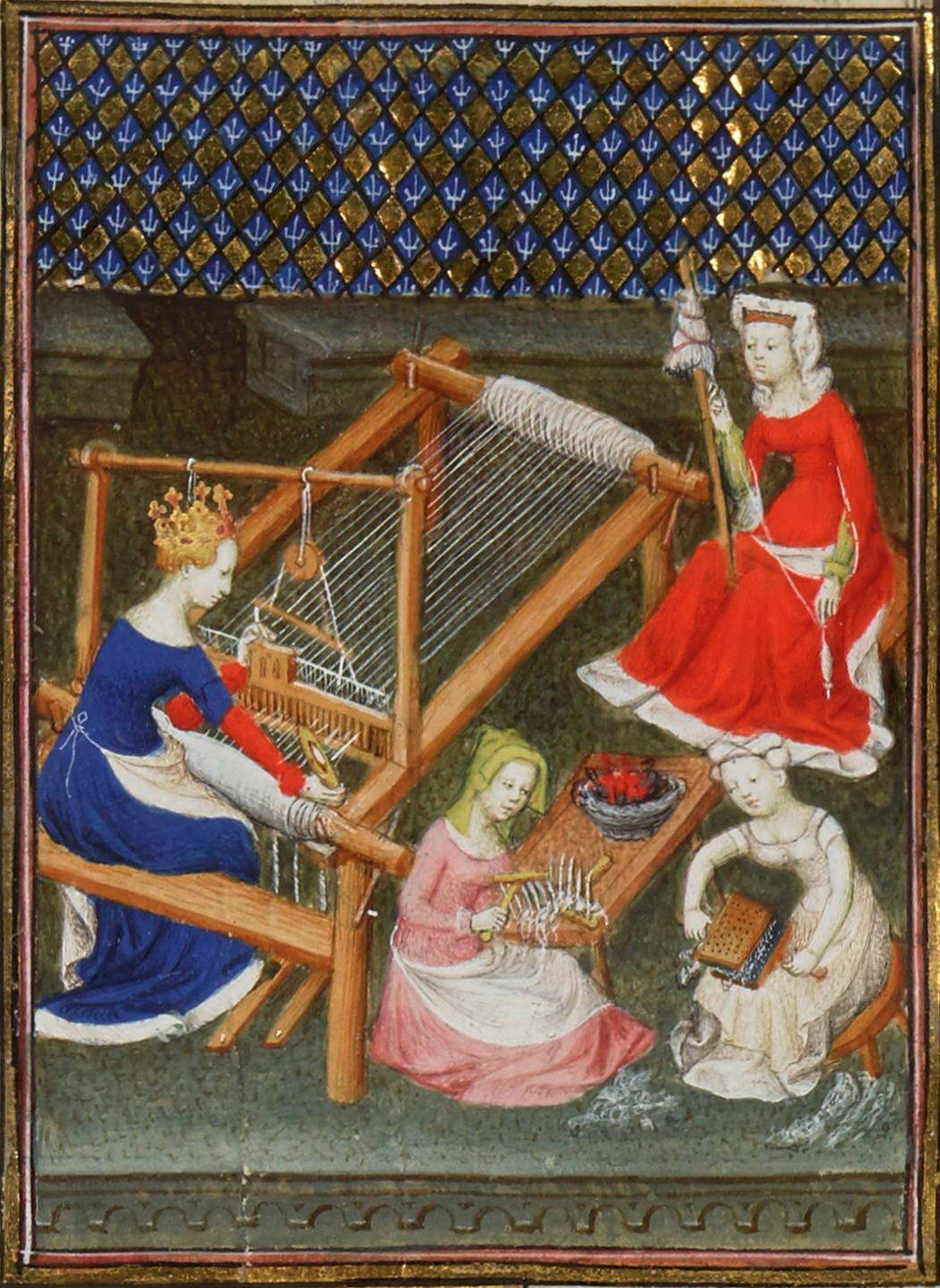
Goliath's weaver's beam is the key for the comprehension of the origin of the whole story of David and Goliath: there isn't really any fight between the two of them, because they are only the reinterpretation of the operation of the hauling Beetle of the Grand Gallery. The Beetle was a wooden gantry in two parts that were connected on the top and designed to accommodate 6 crewmembers who were putting the windlass drive shaft into motion to raise the impactor to the top of the Gallery.
The Pyramids of the Cold v2 (May-September 2023) • Epilogue Part Four
Section 43 • David, Saul, two giant Goliaths, five little stones, an aeolian harp... and a weaver's beam
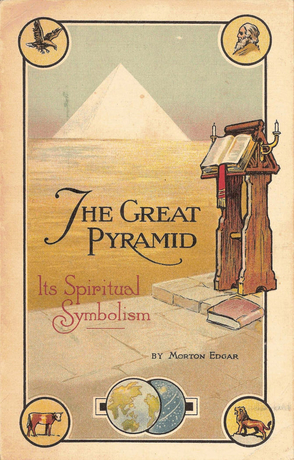
Introduction: we've already seen that when ancient Egyptians engaged themselves in the process of scientific and technological glorification by creating what is known today as the ancient Egyptian religion, it was for their own benefit, and that they've used this religion as a stronghold on the people in order to legitimate their reigns.
In other words, the ancient Egyptian religion has been created by the pharaohs as a tool to control the Egyptian people and influence the entire ancient world.
At the end of the pharaonic era, when pharaohs' power declined, so did their religion, and it is in this context that the Jewish religion emerged; but what we've also seen in the very last Sections of that study, is that this new religion didn't come from nowhere: the Jewish religion did actually two major things:
• first, it completely reinterpreted the ancient Egyptian religion, but only by focusing on the operation of the impactor and by glorifying this impactor into their god, Yahweh.
• second and more importantly, it completely disregarded the final goal of the ancient Egyptian religion: the control over the people.
That second point is absolutely crucial: when pharaohs created and used their religion to control their people, the Jewish religion has only been created to help and sustain the people...
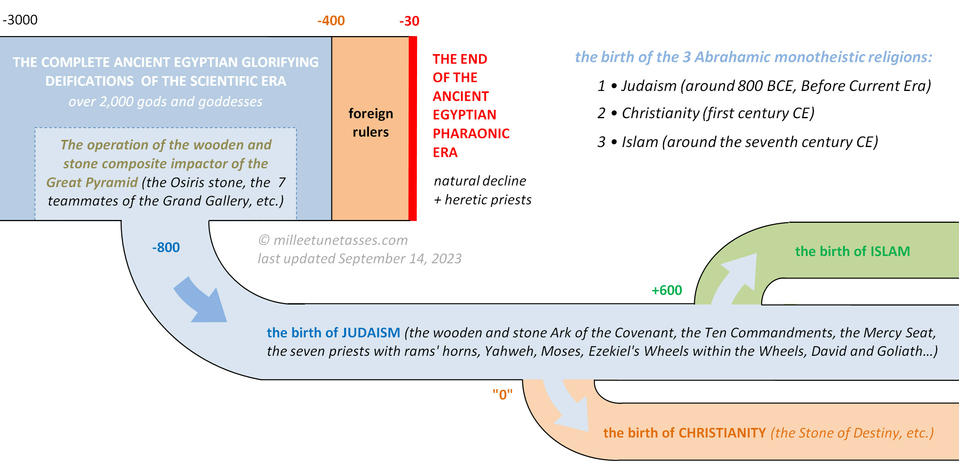
The birth of the three Abrahamic religions, Judaism, Christianity and Islam, from the ancient Egyptian religion.
... In other words, the ancient Egyptian religion has been created by and for the ruling class as a simple tool towards their people, when the Jewish religion has only been made for the people themselves, to help them in their everyday life and to assemble them into a strong community, independently from their rulers.
In short: Hebrews are real heretics, and it probably has something to do with the eternal persecution that Israel is constantly facing in the region. I would say it is only logical, that the Jewish religion was born by some ancient Egyptian heretic priests, who would have seen the change coming with the decline of the pharaoh's political influence, and who would have use their knowledge on how was operated the Great Pyramid, to create a new religion, fully designed for the people themselves.
These heretic Egyptian priests would have chosen the most outstanding part of the Great Pyramid's operation, i.e. the impactor, and would have completely reinterpreted and reinvented its nature and its entire operating process.
In the previous Epilogue Sections, we've already seen what really were Yahweh, Ishmael, Isaac, Moses, Aaron and Ezekiel all about, in this Section we'll discover what Saul, David and Goliath are also all about, the thing, the big thing I was still missing in the Jewish reinterpretation of the Grand Gallery's operation: the hauling Beetle.
We'll see that the "giant beast" Goliath (or should I say the two Goliaths), is that hauling Beetle.
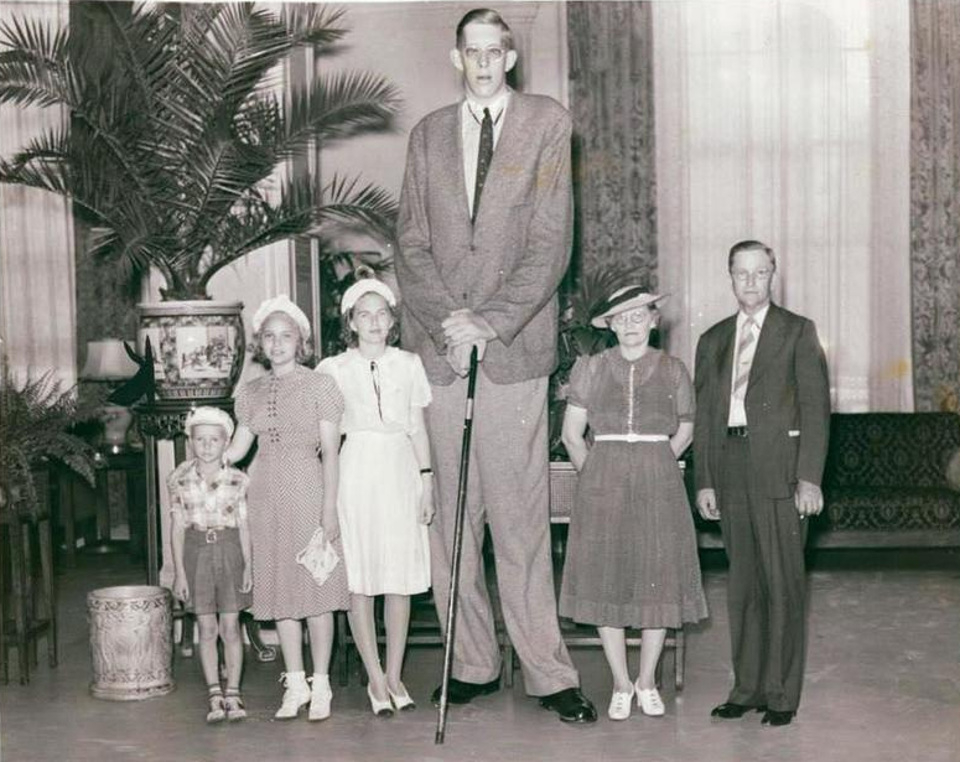
Robert Wadlow is the tallest person in documented history. Due to an overactive pituitary gland, he was taller than his father at age 8 and continued to grow reaching 8 feet 11 inches for 230 kg at age 22. Pictured with his family at age 21, Robert Wadlow died at age 22.
43.01 The incredible description of Goliath at about 3 meters high, though ferocious and as strong as an ox!
Many people, including scholars, doubt that the David and Goliath story is real, and not just because of the size of the giant, which would have made Goliath taller than the famous "tallest human ever" Robert Wadlow.
Robert Wadlow gained his formidable height because of an abnormally high level of human growth; he had a very poor health and died at the age 22 because of it. By comparison, Goliath's height would have been 2.97 meters (about 30 cm more than Robert Wadlow), and he would have been strong as an ox.
"Robert Pershing Wadlow (February 22, 1918 – July 15, 1940), also known as the Alton Giant and the Giant of Illinois, was an American man who was the tallest person in recorded history for whom there is irrefutable evidence. He was born and raised in Alton, Illinois, a small city near St. Louis, Missouri. Wadlow's height was 8 ft 11.1 in (2.72 m) while his weight reached 439 lb (199 kg) at his death at age 22. His great size and his continued growth in adulthood were due to hypertrophy of his pituitary gland, which results in an abnormally high level of human growth hormone (HGH)."
"The oldest manuscripts, namely the Dead Sea Scrolls text of Samuel from the late 1st century BCE, the 1st-century CE historian Josephus, and the major Septuagint manuscripts, all give Goliath's height as "four cubits and a span" (6 feet 9 inches or 2.06 metres), whereas the Masoretic Text has "six cubits and a span" (9 feet 9 inches or 2.97 metres). Many scholars have suggested that the smaller number grew in the course of transmission (only a few have suggested the reverse, that an original larger number was reduced), possibly when a scribe's eye was drawn to the number six in line 17:7." https://en.wikipedia.org/wiki/Goliath
43.02 The scholar attempts to diminish Goliath's height
Because of his exaggerate gigantic height which actually discredit the whole story just by itself, scholars have tried to find a way to diminish it, arguing that the 2.97 meters did include Goliath's spear; and this is quite funny, because most of the time, scholars never, ever even try to go with metaphors; but this is what they do here: they finally come to metaphors. Alleluia.
And guess what: they're right; there really is a metaphor in the height of Goliath. Except that this metaphor isn't exactly in Goliath's height: the metaphor is in Goliath himself.

"Goliath did not have to stand at 6 cubits, 1 span in order to be measured at that size. The description of Goliath, when read in Hebrew, is an awkward one. I’ll transcribe it here: waytz’ iysh-habenayim mi-mahhanoth pelistiym GAL-YATH shamwo mi-gath gabhwo shesh ‘amoth wa-zareth
וַיֵּצֵא אִישׁ־הַבֵּנַיִם מִמַּחֲנוֹת פְּלִשְׁתִּים גָּלְיָת שְׁמוֹ מִגַּת גָּבְהוֹ שֵׁשׁ אַמּוֹת וָזָרֶת
The term iysh-habenayim, translated as “champion”, is literally formed from iysh or “man” and the dual form of beyn, which means “the two between”. Like so many other terms associated with the Philistines, this word appears only here. It is as if the writer of 1 Samuel had to invent a term for what Goliath was doing.
Likewise, the description of his height, gabhwo shesh ‘amoth wa-zareth, is an interesting phrase. Gabh means “height” and the -wo at the end is usually translated “whose” or “his” although it is simply a fixative and not a pronoun. It identifies the connection to Goliath, but it does not imply that this is his physical height. In fact, in light of the rest of the description, it might be better to interpret the passage in terms of his impressiveness in terms of his fully armored state.
Allow me to put it another way. When you looked at Goliath, sheathed in armor and grieves, you saw everything including his spear. This means the height description might not just be his physical person but also his spear’s height as well. He was, after all, not just a man (ish). He was the man who stands between the two (iysh-habenayim) and that title seems to have come with the armor and the weaponry.
Why couldn’t the height descriptor be of Goliath in all his regalia, thus including his spear? When the Hebrews wished to describe someone’s physical height, they had perfectly capable descriptors as when they described Saul as head and shoulders above all other men. Being a champion meant that Goliath was probably bigger and stronger than Saul, otherwise Saul would not have hesitated to fight him. Goliath was a giant, no doubt about it, but in my opinion, he was probably around 7 feet tall, not 10. People disagree, and that’s ok."
Excerpt from "Some Thoughts on Goliah of Gath", November 1, 2010 By Erik DiVietro from Bedford Road Baptist Church: https://www.bedfordroad.org/some-thoughts-on-goliah-of-gath/
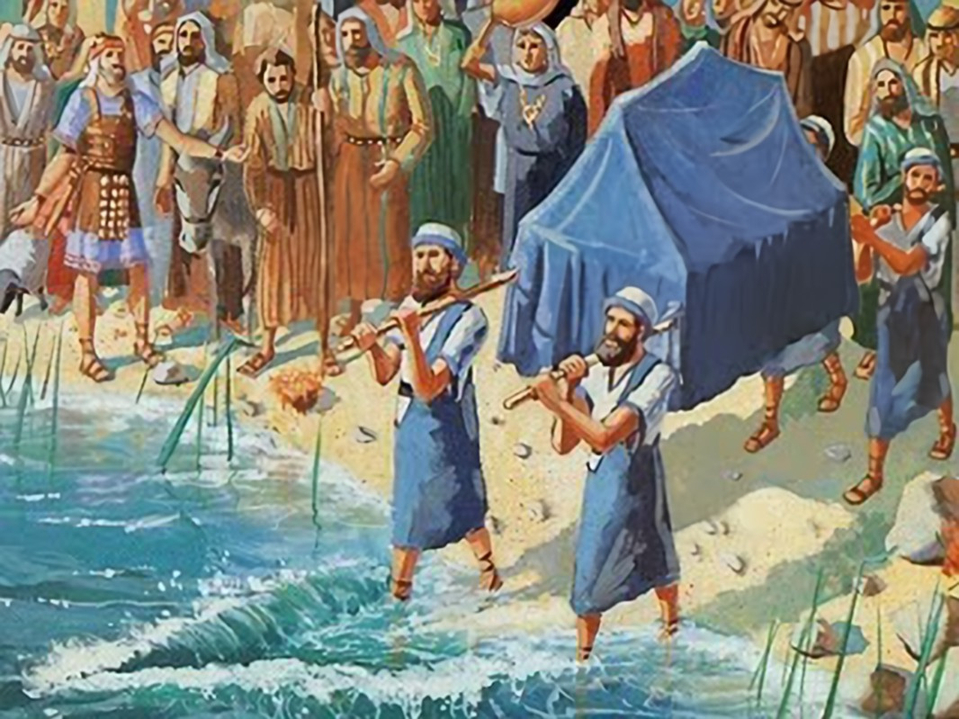
Artistic representation of the Ark of the Covenant (the impactor of the Great Pyramid) penetrating waters.
43.03 Goliath is the one who "had captured" the Ark of the Covenant... because Goliath is the Beetle
I think what made me understand what really was representing Goliath, is the following excerpt:
"The Talmud stresses Goliath's ungodliness: his taunts before the Israelites included the boast that it was he who had captured the Ark of the Covenant and brought it to the temple of Dagon, and his challenges to combat were made at morning and evening in order to disturb the Israelites in their prayers. His armor weighed 60 tons, according to rabbi Hanina; 120, according to rabbi Abba bar Kahana; and his sword, which became the sword of David, had marvelous powers. On his death it was found that his heart carried the image of Dagon, who thereby also came to a shameful downfall." https://en.wikipedia.org/wiki/Goliath
It is only because we've already seen in Section 40, that the Ark of the Covenant, though complex in its full understanding, is mostly a reinterpretation of the Great Pyramid's impactor, that we can now decipher Goliath, because the one thing which really "captured the Ark" (captured the impactor) and "brought it to a temple" (for some reason the top of the Gallery is here compared to the entry of a temple), that is the hauling Beetle.
In short: Goliath is the reinterpretation of the hauling Beetle of the Gallery, and from there, this is the entire story of David and Goliath which can be correctly deciphered.
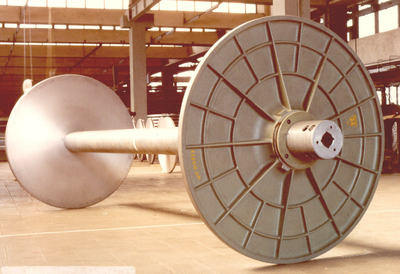
43.04 The apparent "irrelevent" weaver's beam metaphor about the staff of Goliath's spear
To understand Goliath's height metaphor, we first have to understand something that nobody is really interesting in, and that is the weaver's beam metaphor. Scholars are explaining that the weaver's beam metaphor is about the shape, size and diameter of the staff of Goliath's spear. But do you think appropriate to compare the staff of the main weapon of the most deadly fighter on earth, with a part of a weaving machine, which would most probably have been operated most of the time by women?
Does it seem right? Of course it doesn't. The weaver's beam metaphor isn't simply about two pieces of wood that simply look alike, and I'm not even sure it could be categorized as a metaphor in the first place; and if it is, it would be a very poor metaphor.
Anyway, the weaver's beam metaphor is so important in regards to Goliath, that it actually appears many more times in the scripture:
1 Samuel 17:7 at https://www.kingjamesbibleonline.org/1-Samuel-17-7/
4 And there went out a champion out of the camp of the Philistines, named Goliath, of Gath, whose height was six cubits and a span. 5 And he had an helmet of brass upon his head, and he was armed with a coat of mail; and the weight of the coat was five thousand shekels of brass. 6 And he had greaves of brass upon his legs, and a target of brass between his shoulders. 7 And the staff of his spear was like a weaver's beam; and his spear's head weighed six hundred shekels of iron: and one bearing a shield went before him. 8 And he stood and cried unto the armies of Israel, and said unto them, Why are ye come out to set your battle in array? am not I a Philistine, and ye servants to Saul? choose you a man for you, and let him come down to me. 9 If he be able to fight with me, and to kill me, then will we be your servants: but if I prevail against him, and kill him, then shall ye be our servants, and serve us. 10 And the Philistine said, I defy the armies of Israel this day; give me a man, that we may fight together.
2 Samuel 21:19 - And there was again a battle in Gob with the Philistines, where Elhanan the son of Jaareoregim, a Bethlehemite, slew the brother of Goliath the Gittite, the staff of whose spear was like a weaver's beam.
1 Chronicles 11:23 - And he slew an Egyptian, a man of great stature, five cubits high; and in the Egyptian's hand was a spear like a weaver's beam; and he went down to him with a staff, and plucked the spear out of the Egyptian's hand, and slew him with his own spear.
1 Chronicles 20:5 - And there was war again with the Philistines; and Elhanan the son of Jair slew Lahmi the brother of Goliath the Gittite, whose spear staff was like a weaver's beam. https://www.goliathsspear.com/weavers-beam
Above image: a modern industrial weaver's beam at https://rostoni.com/prodotto/subbio-somet-800/
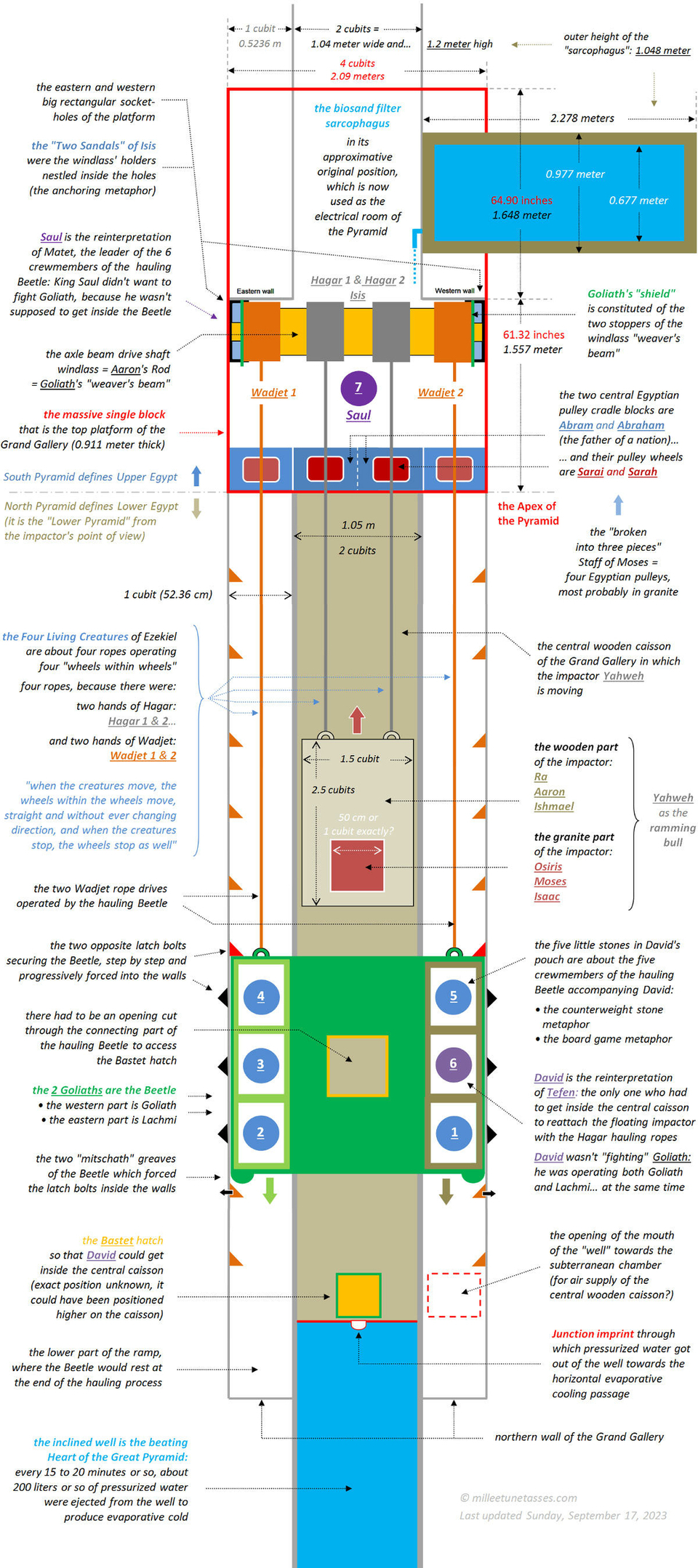
Operation of the Grand Gallery of the Great Pyramid of Egypt: the hauling of the impactor by the Beetle. The top platform of the Grand Gallery is made of one single giant block, that goes way after the south wall of the gallery towards the antechamber: the block is way bigger than what we can see of it, exactly like it is for the girdle stones of the inclined well. Dimensions of the block are from Petrie's book "The pyramids and temples of Gizeh. Antechamber and passages", section 47 (page 75). Petrie, W. M. Flinders (William Matthew Flinders), Sir, 1853-1942: https://archive.org/details/cu31924012038927/page/n113/mode/2up
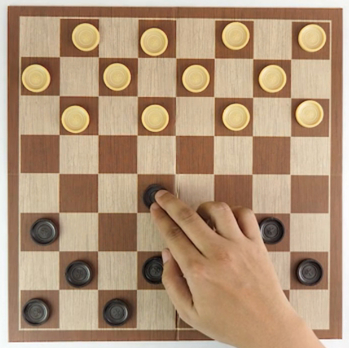
43.05 The five little stones that David is carrying with him are his five teammates in the Beetle
There are many explanations you can read on the internet about why did David took five little stones from a brook before his fight with Goliath, but of course none is correct.
We know that the whole team operating the Grand Gallery had 7 teammates and that Saul and David were part of that team; in other words, there are exactly five teammates missing… and of course they are the five little stones.
There are at least two metaphors that have been used for these stones:
• the counterweight metaphor: when you think it through, the operation of the impactor was finally pretty close to the operation of a scale, with the weight of the impactor that needed to be opposed with another weight, a counterweight; and the Beetle with its crewmembers was this counterweight; so if you are missing 5 crewmembers, you also are missing five little counterweights, i.e. five little stones
• the board game metaphor: this is my favorite I have to admit, because one way of looking at the crewmembers inside the Beetle, would be to compare them as the stones you can use on a board game, simply because each and every single crewmember would have had to be like "imprisoned" inside his own little "cell"… or his own little "square" on a game grid on which you would put a little stone.
Then he took his staff in his hand, chose five smooth stones from the stream, put them in the pouch of his shepherd’s bag and, with his sling in his hand, approached the Philistine. 1 Samuel 17:40 New International Version (NIV): https://www.bible.com/bible/compare/1SA.17.40
"Go is an abstract strategy board game for two players in which the aim is to surround more territory than the opponent. The game was invented in China more than 2,500 years ago and is believed to be the oldest board game continuously played to the present day. A 2016 survey by the International Go Federation's 75 member nations found that there are over 46 million people worldwide who know how to play Go, and over 20 million current players, the majority of whom live in East Asia. The playing pieces are called stones." https://en.wikipedia.org/wiki/Go_(game)
Board Games, "How to Play Checkers", co-authored by J. Davidson: https://www.wikihow.com/Play-Checkers
43.06 The probable position of David (Tefen) in the middle row of the hauling Beetle
There are two arguments that could indicate that contrary to the previous draws I've made of the Beetle, Tefen (David) wasn't positioned in the first (lower) row of the Beetle, but in the middle row:
• first, because we've already seen in Section 26 (the 10 operating phases of the Gallery) that the crewmembers of both the first (lower) and last (upper) rows did have to get out of the Beetle to deal with the latch bolts (when the Beetle was at the top of the Gallery, the crewmembers of the lower row had to get out of it and reset the latch bolts out of the walls, before getting back up to the Beetle; and when the Beetle was at the bottom of the Gallery, the crewmembers of the upper row had to get out of the Beetle to force the latch bolts back into the walls so that the Beetle could be brought back to the top of the Gallery); and because of all this extra duty, probably the task of dealing with the Bastet hatch would have rested on the two crewmembers of the central row.
• second, because of the way the ramps are extending below the lever of where is located the Junction imprint: it looks like when the Beetle would have rest onto the northern wall of the Gallery (at the very bottom), then the Junction imprint would have naturally placed itself at about the center of the Beetle (see the draw). But I also have to point out that the draws I've made are very far from being at perfect scale, so it is really possible that this particular part of the design is just wrong.
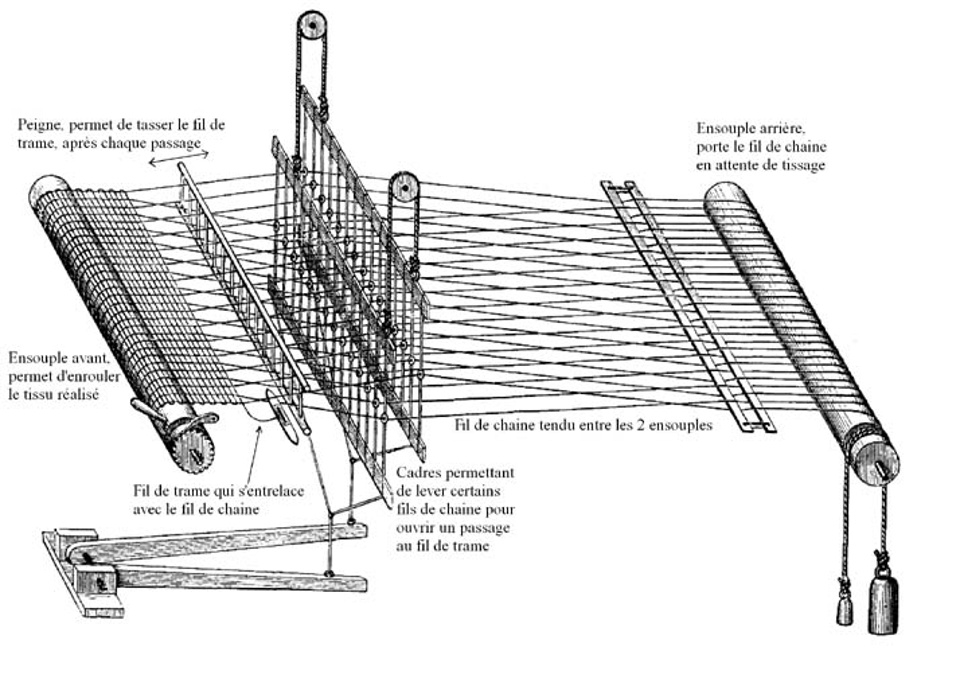
The operation of a weaver, showing the upper weaver's beam and the two counterweights: http://www.compagnons-duellistes.fr/wp-content/uploads/2011/04/Principe_Metier.jpg
43.07 Both the weaver's beam and the harp metaphors are about the same thing: the operation of the hauling and driving ropes of the Grand Gallery
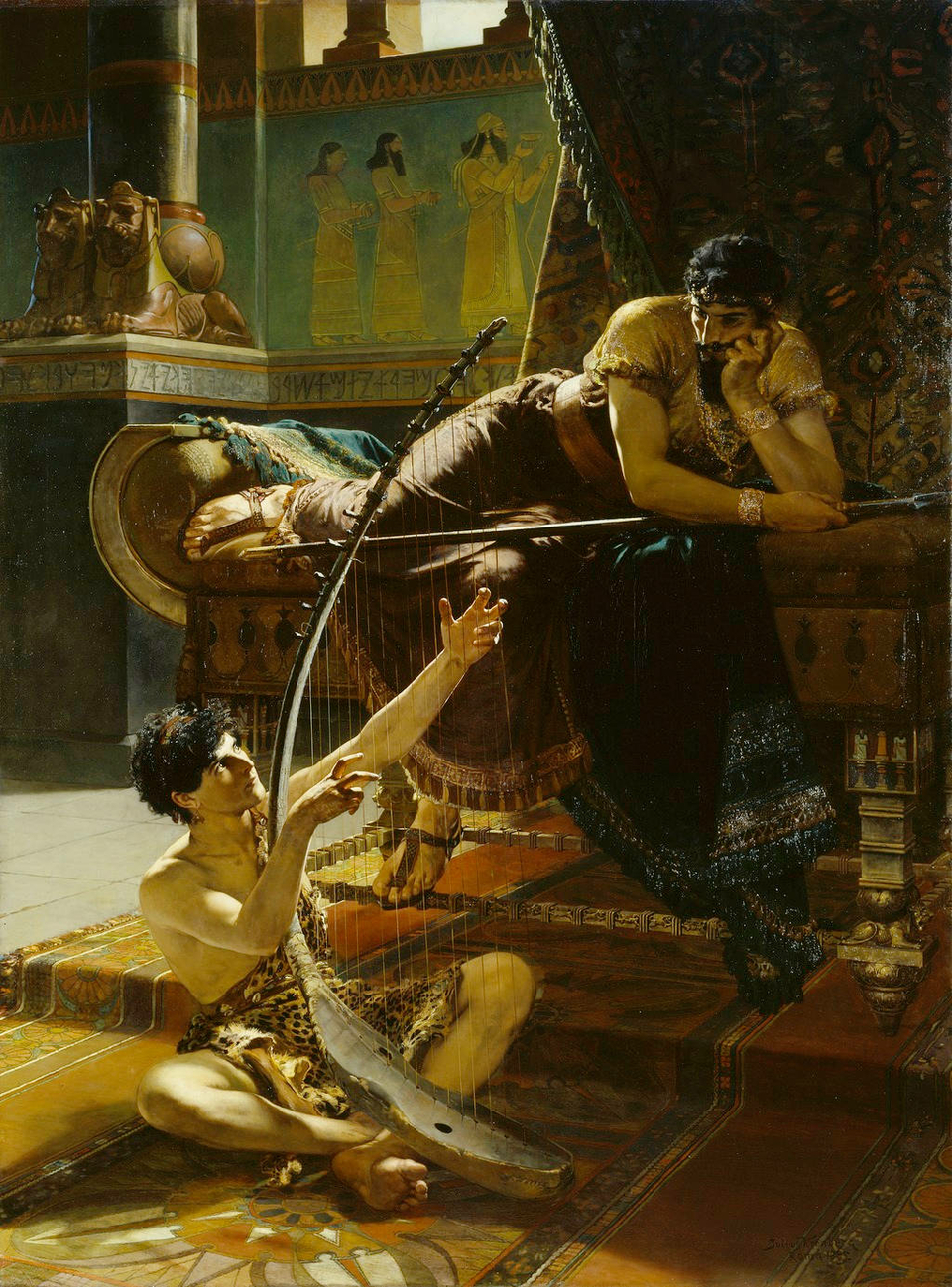
David playing the harp before Saul, King of the Israelites. Look at how David seems to be trying to get to Saul, raising himself up with the strings (the ropes) of the harp. Painting by Julius Kronberg (1885) at the Nationalmuseum (National Museum of Fine Arts in Stockholm, Sweden), slightly edited for enhanced clarity: https://commons.wikimedia.org/wiki/File:David_and_Saul_(Julius_Kronberg)_-_Nationalmuseum_-_18384.tif
43.08 If the weaver's beam metaphor is perfect for the windlass, the harp metaphor is perfect for the ropes
I'm really sorry to say that just like in the ancient Egyptian religion, everything that is written in the Bible is only metaphorical; metaphors are the real secret, and they are plenty of them about David; one of them being is exceptional ability to play the harp.
I know it demands a lot of effort to imagine ourselves inside the Grand Gallery, 4,500 years ago when the Beetle was still being operated by the 6 crewmembers who were on board, but you should really take the time to do so: imagine the atmosphere, imagine the sound of fresh air filling up the central wooden caisson through the Bastet hatch at the northern end of the Gallery, and imagine what kind of sounds the four ropes under tension would have made.
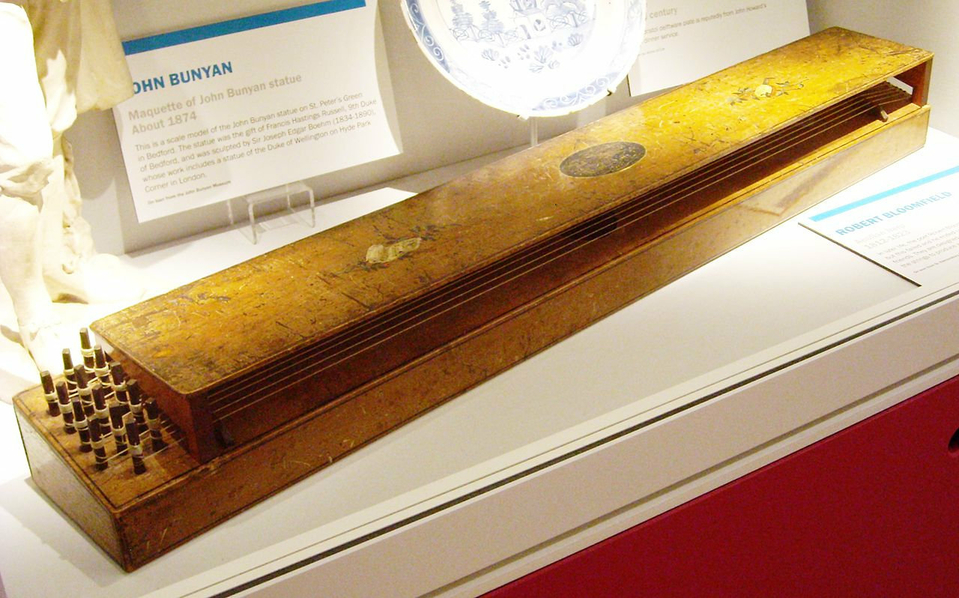
An aeolian harp with the strings passing through the inside of the wooden box, made by Robert Bloomfield between 1812 and 1823. The Higgins museum and gallery, Bedford. Picture by Simon Speed: https://en.wikipedia.org/wiki/Aeolian_harp#/media/File:BloomfieldAeolianHarp.JPG
43.09 If David's "special hanging harp" is described just like an aeolian harp, it is because it is only referring to the central wooden caisson "hanging" down inside the Grand Gallery from the top platform
We've already seen that ancient Egyptians already had glorified this particular part of the operation of the Gallery, in the Lamentations of the Twin Sisters Isis and Nephthys (Section 23); but the Bible is much more explicit, because it is the very origin of the story of the north wind blowing upon King David's harp.
The metaphor is simply beautiful: the four ropes of the Grand Gallery being compared to the strings of a harp and played by the wind; but the metaphor doesn't stop there because a harp also has a wooden soundboard, and because the Grand Gallery had its own with the central wooden caisson. Even better: every soundboard has at least one hole to let the sound get out of the instrument, and of course the central caisson has its own hole with the Bastet hatch.
And then it continues with another metaphor, and this time it is pretty much the same one we've already seen in previous Section 42 when Ezekiel is supposed to eat an unrolling scroll; here it is David that is literally "unrolling the scroll" (i.e. unwinding the ropes), when he is pictured "studying the Torah".
"According to ancient tradition, King David possessed a special harp that he hung above his bed. At midnight, a north wind would come and blow upon it — and the harp would start to play. David would immediately arise and study Torah until the break of dawn. (Berachot 3b)." https://ravkooktorah.org/SHIR64.htm#:~:text=David's%20Harp,(Berachot%203b).
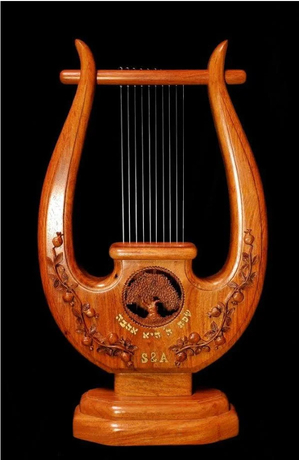
Kinnor David harp, crafted in Jerusalem by Levite Micah Harrari: https://www.harrariharps.com/kinnor-david
43.10 The four ropes of the Grand Gallery and the Fourfold song unfolding inside the "Tree of Life" caisson
Even if one of the most important changes I had to make in previous Section 42, about the operation of the Grand Gallery, was that they weren't only 3 but 4 ropes, and even if each and every one of them would have been most probably designed to be identical in all points, surely they were actually all slightly different from one another; and that is probably the origin of the Fourfold Song: each rope would have had its own tone, its own sound; and of course the two central hauling ropes caught inside the caisson and connected to the impactor would have sound different from the two lateral drive ropes connected to the Beetle.
All together they would have made a very specific sound, they would have created a very specific music… connected to the raising of the impactor; and because we already know that Yahweh is the impactor, and the Tree of Life is the central wooden caisson, it explains perfectly the following excerpt about the Fourfold Song written by Rav Kook: "the Divine Name – יהוה-YHVH [Yahweh] – is a FourFold Song that unfolds into the Tree of Life."
"The Fourfold Song is one of Rav Kook’s most important and all encompassing teachings. He wrote it in Switzerland in 1915 as World War One was raging in all the countries around him. […] This prose poem is an expansion of a statement found in the Tikkunei HaZohar that the Divine Name – יהוה-YHVH [Yahweh] – is a FourFold Song that unfolds into the Tree of Life. The Yud expanded into Yud Heh, then Yud Heh Vav, then Yud Heh Vav Heh […]
Rav Kook explains how the integration of these four core letters represent the four core identities that we need to give full expression to in order to live a life singing the Song of Songs:
שיר מרובע The Fourfold Song: “There is the one who sings the song of their own life, and in themselves they find everything, their full spiritual satisfaction. There is the one who sings the song of their own nation, attaching themselves with a gentle love to the whole community of Israel. Together with her he sings her songs. There is the one who reaches toward more distant realms, going beyond the boundary of Israel to sing the song of humankind. Then there is the one who rises towards wider horizons, linking themselves with all existence, with all God’s creatures, with all the worlds, and singing their song with all of them. And then there is the one who rises with all these songs in one ensemble, all joining their voices. Together they sing their songs with beauty, each one lending vitality and life to the other. These are songs of joy and gladness, jubilation and celebration, ecstasy and holiness. The song of the Self, the song of the Nation, the song of all Humankind, the song of all Existence merge together at all times, in every moment.
And this full comprehensiveness rises to become the song of holiness, the song of God, the song of Israel, Israel - Shir El - the Divine Song, a simple song, a twofold song, a threefold song, a fourfold song, The Song of Songs of Shlomo/Solomon – The Sovereign with whom is Shalom-Peace.” (Notebook 7: 112)": https://haorot.com/the-four-worlds/
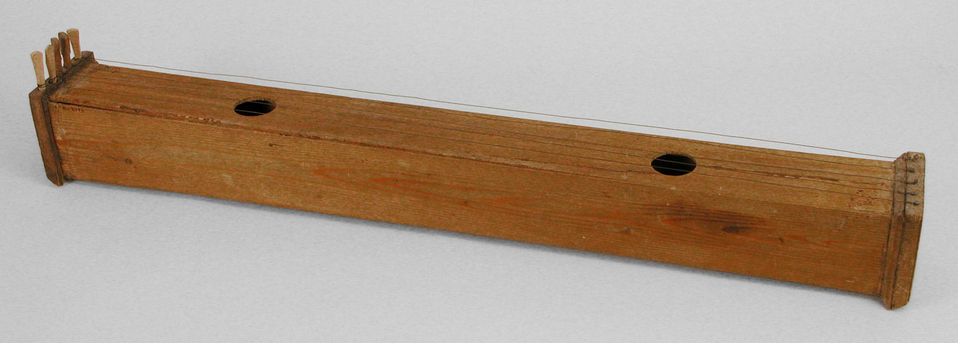
Aeolian harp, with the strings of the instrument passing over the wooden structure of the box, with two holes for the air. "Aeolian harp, four-sided box of thin spruce wood. On the front side two round sound holes, end pieces run slightly over the sides and form a stand and string holder, 5 strings with wooden screws." Blekinge museum collection at Karlskrona, Sweden: https://blm.kulturhotell.se/objects/c32-7220/
43.11 The aeolian harp model of the central wooden caisson both surrounded and penetrated by the ropes
The above artifact, an aeolian harp box, is the perfect illustration of the real meaning of the David's harp metaphor. But it also raises the issue of the real origin of these "aeolian harps": it is possible that these harps not just only look like the central wooden caisson penetrated or surrounded by the ropes of the Grand Gallery, but that they really all are about the caisson.
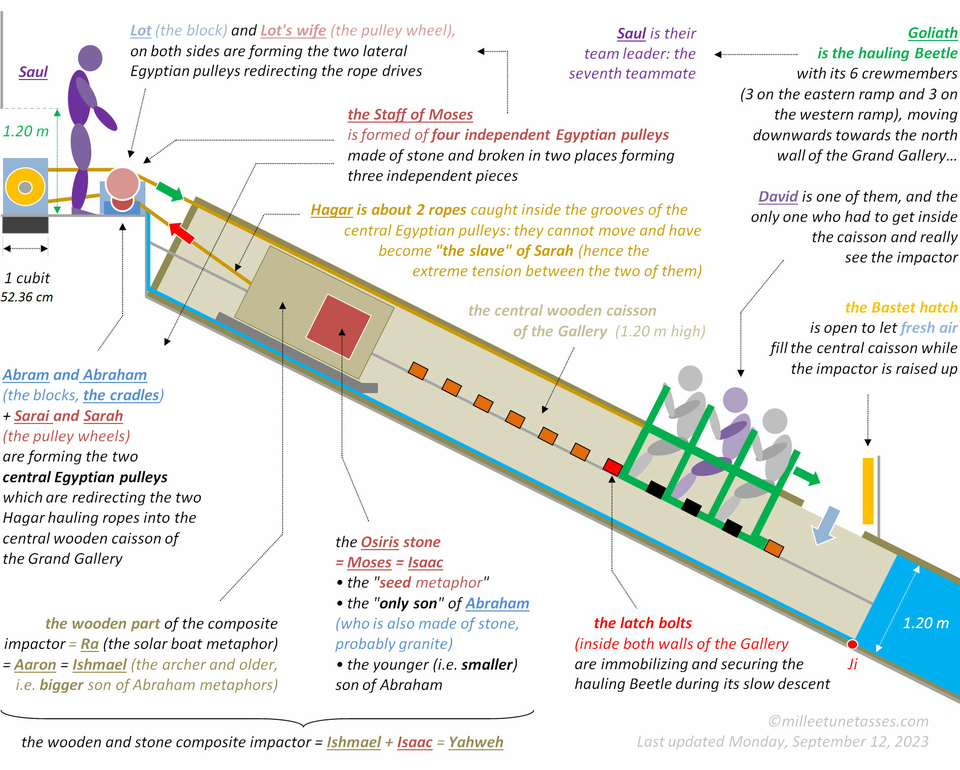
The Grand Gallery's basic operation inside the Great Pyramid of Egypt and showing the two Staffs of Aaron and Moses: respectively a driving shaft and a guiding shaft. In many ways, the impactor was more or less operated just like the anchor on a modern ship.
43.12 King Saul didn't fight Goliath because the team leader of the Gallery didn't get inside the Beetle
If I'm right about the hypothesis that it is some ancient Egyptian heretic priest(s) who wrote the Bible, with the idea of banishing the pharaoh's influence out of the everyday life of the Egyptian people; i.e. giving to the people a completely independent religion of their own, then the problem of the origin of this religion (the fact that it entirely rely on the operation of the Great Pyramid) really doesn't matter that much.
What was important was to reinterpret what was already known by the people because of the ancient Egyptian religion, and build en entire new religion that would have made them a real community, sharing common stories and values.
The David and Goliath story is probably one of the most famous of these stories, and you can find on the internet endless numbers of sites explaining all the values which are applying to the story, and in particular why Saul didn't accept Goliath's challenge to fight.
What I'm describing here, is just what is the original historical event on which the story was built, but again: it is very important to me, but it doesn't have to be that way for anyone engaged into the Jewish religion. It is actually exactly the same thing that you do when you drive your car; you don't need to know every single piece of the car, nor you need to know how and why a piece is working with all the other pieces: you just need to know how to drive the whole thing. I'm just seeing myself as the engineer who had to design every single piece of the car, and who had to make them work properly all at the same time.
In the David and Goliath story, Saul is the king, the first monarch of Israel, but he declines the challenge to fight Goliath; and what I'm explaining here, is only what is behind the scene: if King Saul didn't fight Goliath, it is only because Saul is referring to the team leader of the Grand Gallery. Saul is the reinterpretation of Matet, the ancient Egyptian glorification of the seventh teammate who operated the hauling Beetle of the Gallery; and if Saul refused to fight Goliath, it is only because the team leader of the Gallery wasn't supposed to get in the Beetle.
Saul (Hebrew: שָׁאוּל, Šāʾūl; transl. "asked/prayed for") was, according to the Hebrew Bible, the first monarch of the United Kingdom of Israel. His reign, traditionally placed in the late 11th century BCE, supposedly marked the transition of Israel and Judah from a scattered tribal society ruled by various judges to organized statehood.
The historicity of Saul and the United Kingdom of Israel is not universally accepted, as what is known of both comes exclusively from the Hebrew Bible" https://en.wikipedia.org/wiki/Saul
" In 1 Samuel 17, Saul and the Israelites are facing the Philistines in the Valley of Elah. Twice a day for 40 days, morning and evening, Goliath, the champion of the Philistines, comes out between the lines and challenges the Israelites to send out a champion of their own to decide the outcome in single combat, but Saul is afraid. David accepts the challenge. Saul reluctantly agrees and offers his armor, which David declines, taking only his staff, sling, and five stones from a brook. […] The underlying purpose of the story of Goliath is to show that Saul is not fit to be king (and that David is). Saul was chosen to lead the Israelites against their enemies, but when faced with Goliath he refuses to do so". https://en.wikipedia.org/wiki/Goliath
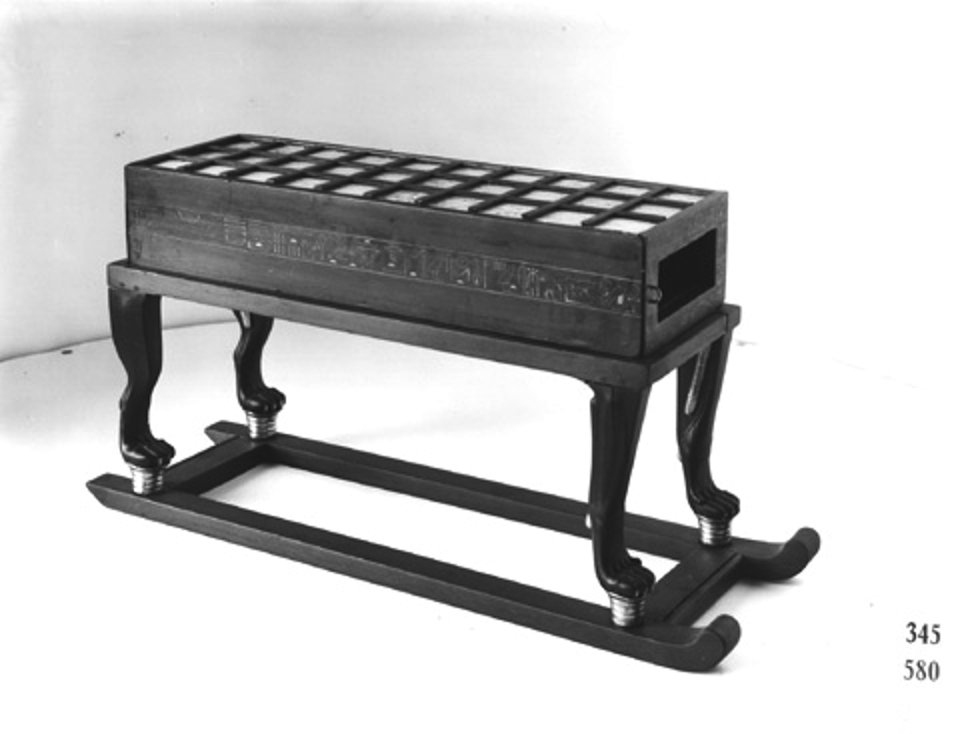
Game-box on sledge runners at The Griffith Institute. Tutankhamun: Anatomy of an Excavation (The Howard Carter Archives), photograph by Harry Burton: http://www.griffith.ox.ac.uk/gri/carter/345-p1248.html
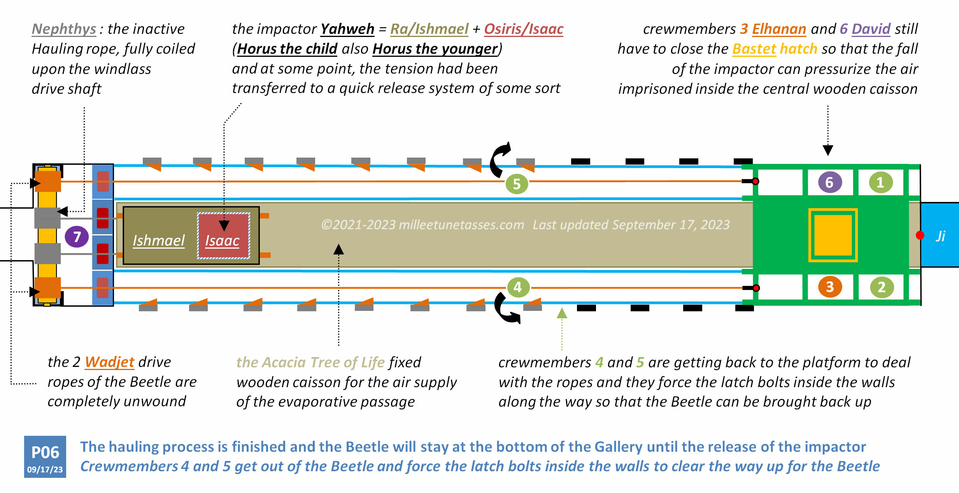
43.13 Operating phase P6 of the impactor: the hauling process is finished and crewmembers 1 and 2 are hoping their way up the Gallery, while the hauling Beetle is still waiting "facedown" against the north wall
At this stage, the impactor has been raised and the hauling process is finished; crewmembers 1 and 2 then leave the hauling gantry Beetle and start hoping their way up towards the platform, forcing the latch bolts inside the walls along the way.
This hoping movement of the crewmembers, in and out of their little cells, and from one latch bolt to another, is the origin of the game board metaphor and the reason why there are the Senet game-boxes on sledge runners in the tomb of Tutankhamun.
43.14 David really had to climb and stand over Goliath, the hauling Beetle
There are a few words in 1 Samuel 17:51 that nobody seems to care, but so precious! Everybody focuses on to know how Goliath (the Giant) was killed, they talk about the sword, the "finishing him off" thing, but nobody cares that David "ran and stood over" Goliath. If David would really had to cut off Goliath's head, why the hell did he have to "stand over" him?
The most important words in this excerpt of 1 Samuel 17:51 are they: David "ran and stood over Goliath"; but if you don't know who is really David and what Goliath is really representing, no way you understand these words; because "in real life", in the Grand Gallery, David indeed had to climb up and stand onto the Beetle before getting inside the wooden caisson.
1 Samuel 17:51 (NASB): Then David ran and stood over the Philistine [Goliath], and took his sword and drew it out of its sheath and finished him, and cut off his head with it. When the Philistines saw that their champion was dead, they fled. https://answersingenesis.org/contradictions-in-the-bible/how-did-david-kill-goliath/
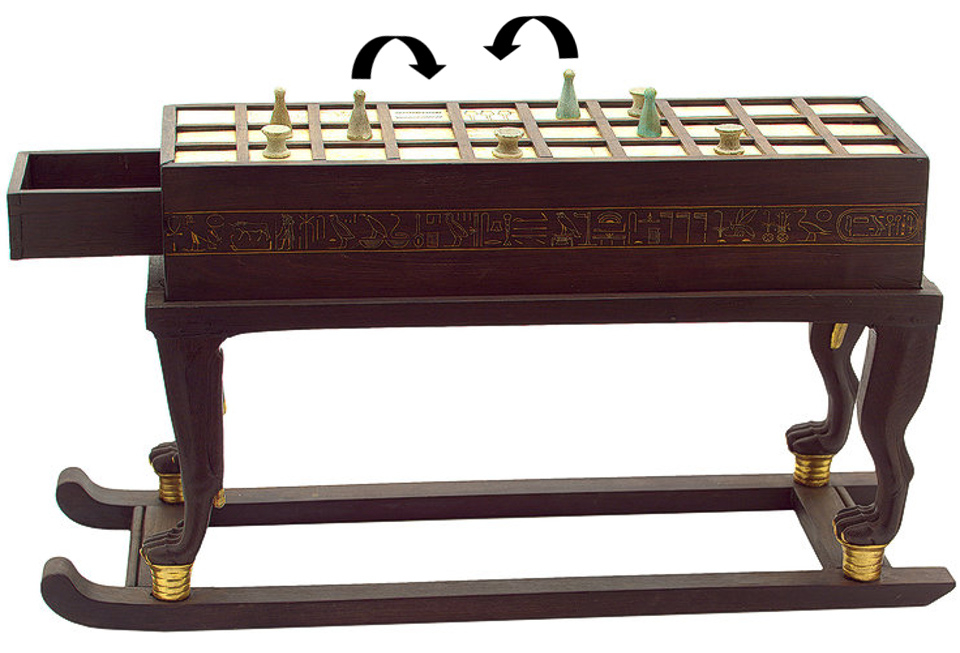
The senet game board of Tutankhamun rests on a stand with animal-shaped legs attached to sledge runners. The stand and sledge are made of ebony. The top and bottom surfaces of the board are veneered with ivory and divided into compartments by raised strips. The game board has a drawer used as storage for the gaming pieces: pawns and knucklebones of ivory and casting-sticks of black ebony and white ivory. The upper side of the board is divided into 30 squares for the senet game; the object of which was to safely navigate all the pieces off the board, while preventing the opponent from doing the same. The reverse side of this game board is laid out for another game that has only 20 squares; it is unclear how this game was played. This image from: https://www.globalegyptianmuseum.org/detail.aspx?id=15033 and
43.15 The crewmembers hoping from one square of the "board game-like" hauling Beetle to another
Once again, with the above artifact, it is the whole complexity and sophistication of the very principle of metaphoric combinations that is at play: you think there is only one thing on the above image of the "board game" from the tomb of Tutankhamun, but there are actually a lot more:
• first, we have the central wooden structure that is the representation of probably not the hauling Beetle in its entirety, but just one half-Beetle, because of the narrowness of the structure
• second, we have the sledge runners on which (most probably) both the Beetle and the impactor would have been set onto
• third, we have the metaphoric representation of how would have looked like the crewmembers of the Beetle, imprisoned inside their own little individual cells, just like stones set into the squares of a game table
• fourth, we have the representation of the Beetle's greaves that would have forced the latch bolts into the walls of the Gallery when the Beetle would have descended the steep slope of the Gallery
• and finally fifth, we have the hollow structure of the central wooden caisson that is supporting the game board
In other words, this "game box" is a concentrate of many metaphoric representations of how was operated the Grand Gallery of the Great Pyramid, and everything is here: the wooden caisson, the Beetle which was like "floating" on top of it on its sledge runners and pushing the latch bolts in the walls, and of course the whole team of crewmembers who kept getting in and out the Beetle to deal with the latch bolts or get into the caisson for David/Tefen, just like the stones of a board game which are hoping from one square to another. And this later metaphor is maybe the cutest of all.
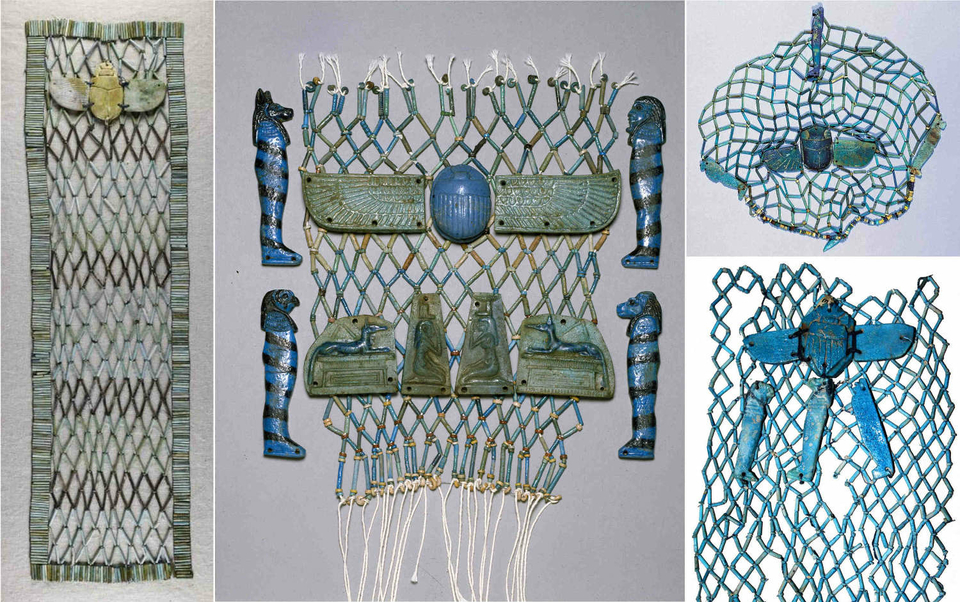
Mummy Bead Net with Winged Scarab, Third Intermediate Period - Late Period, date 1076-332 BCE, at the Michael C. Carlos Museum in Atlanta: https://collections.carlos.emory.edu/objects/38469/mummy-bead-net-with-winged-scarab
Image from the Walters Art Museum: https://art.thewalters.org/detail/28885/amuletic-figure-of-kebehsenuef-son-of-horus/#item-modal
Faience pectoral scarab with spread wings and bead net, Royal Pump Room, Harrogate. This file was donated by Harrogate Museums and Arts service as part of the Yorkshire: https://en.wikipedia.org/wiki/Scarab_(artifact)#/media/File:Bead_net_with_scarab_HARGM3698.JPG
Egyptian Faience at the Australian Museum, Sydney: https://australian.museum/learn/cultures/international-collection/ancient-egyptian/egyptian-faience/
43.16 The scarabs amulets and the fishing nets are both the glorification of the hauling Beetle
I've already used this set of photographs, but it simply becomes more and more clear as time goes by, because what we have here, with the scarab beetle amulets and the dishing nets, is once more time the exact same trick we've already seen so many times: both the fishing net and the scarab amulets are actually about the same thing, and that is the hauling Beetle.
• When the scarab amulets are the glorification of the hauling Beetle because the crewmembers were positioned backwards when descending the Gallery, just like the beetle scarabs are pushing their dung balls backwards, and probably also because it would have looked like a big animal with very short legs…
• The fishing nets are also the glorification of the hauling Beetle, but this time it is because of the way that the crewmembers would have looked like caught in the fishing net's meshes. This particular metaphor is kind of a variation of the game board squares metaphor: they are both referring to the little "cells" or "compartments" where the crewmembers of the Beetle were set.
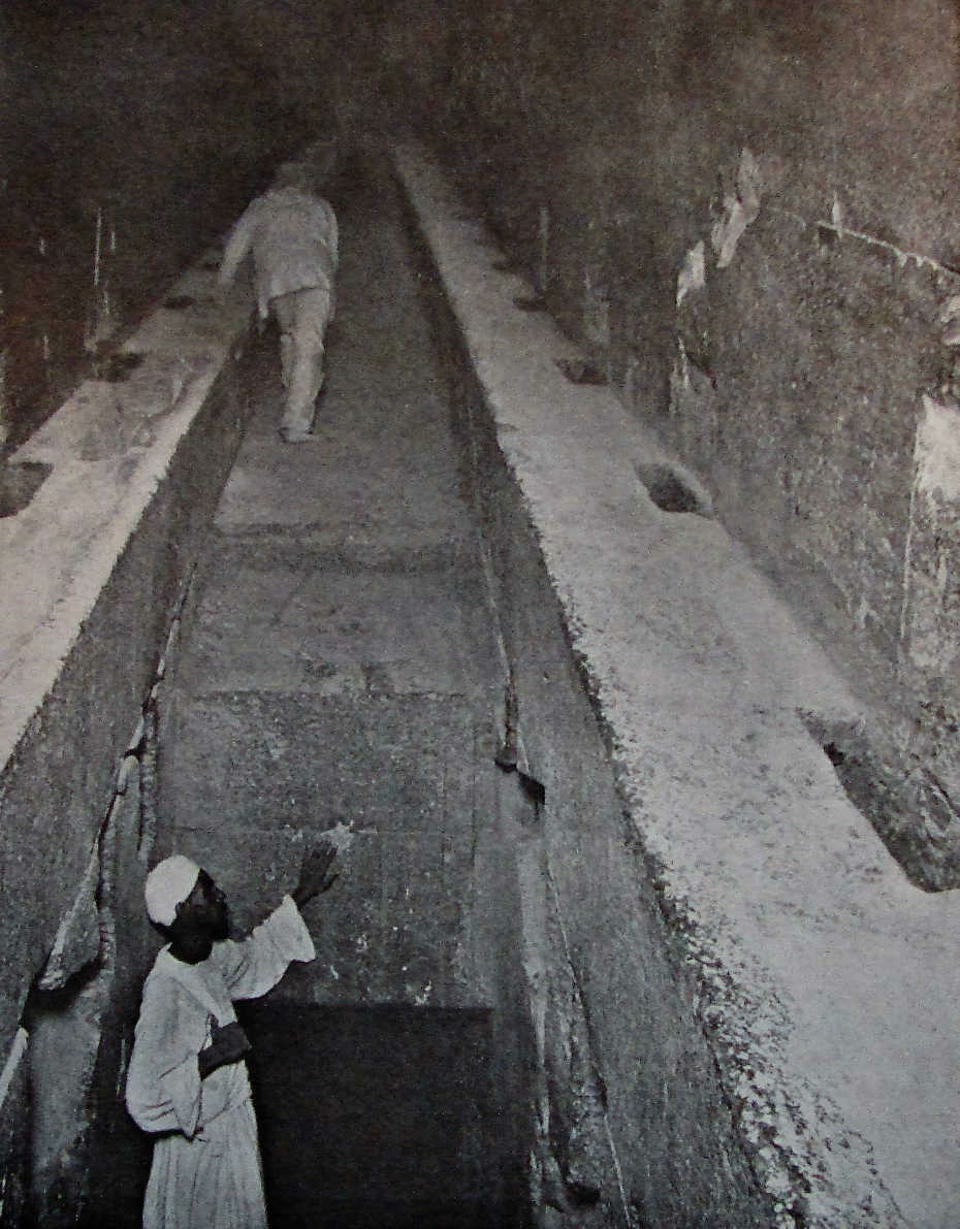
Great Pyramid Passages and Chambers, Volume 1 (1910 edition). By John and Morton Edgar. The Edgars were associates of Charles Taze Russell and wrote this treatise in defense of Russell's views on the prophetic symbolism of the Great Pyramid of Gizeh in Egypt. This volume was advertised in the August 1, 1910 Watch Tower and was sold by the Brooklyn and London branches of the Watchtower Society. It was later revised in 1923. This was circulated among Bible Students (Jehovah's Witnesses) until 1928. Bible Students who retained Russell's teachings still circulate the volume. Plate CLVIII, page 292 "The GRAND GALLERY of the Great Pyramid of Gizeh, looking south, showing the sheer-cut-off of the floor ; and the two Ramps ascending into the darkness beyond.": https://archive.org/details/GreatPyramidPassagesVol11910Edition/page/n300/mode/1up
43.17 It is perfectly known that David and Goliath fought in a valley with "very steep sides", indeed...
The same way, it is perfectly known that the David and Goliath story happened in a valley with very steep sides, but unfortunately this part of the context is systematically disregarded; and still it shouldn't be, simply because these "very steep sides" of the valley are of course referring to the very steep slope of the Grand Gallery.
"At the time of Saul and David, the Philistines were one of Israel's most important enemies. As a people, they were skilled at working with iron forged weapons, which gave them the ability to make impressive chariots. With these chariots of war, they dominated the coastal plains but were not competent in the mountainous regions of central Israel. Why did the Israelites wait 40 days and not beginning the attacks? Everyone was afraid of Goliath. He seemed invincible. Not even Saul had stepped out to fight! But an equally important reason had to do with the characteristics of the land. The sides of the valley were very steep. Whoever made the first move would have a strong disadvantage and probably suffer great loss. Both sides were waiting for the other to attack first." https://www.onepagebiblesummary.com/bat/bat_05.php
43.18 and that David really kept going endlessly "back and forth from Saul"
Probably the major difficulty in the Bible, is that there are so many distracting data that it is very hard to find the genuine information and to understand its importance; but it really is the case here: when the leader of the Beetle's teammates stayed at all times on the platform, the Beetle kept moving up and down, and so did David who kept going back and forth from Saul.
"Now David was the son of an Ephrathite of Bethlehem in Judah, named Jesse, who had eight sons. In the days of Saul the man was already old and advanced in years. The three oldest sons of Jesse had followed Saul to the battle. And the names of his three sons who went to the battle were Eliab the firstborn, and next to him Abinadab, and the third Shammah. David was the youngest. The three eldest followed Saul, but David went back and forth from Saul to feed his father's sheep at Bethlehem. (1 Samuel 17:12-15)": https://www.christianity.com/wiki/bible/bible-story-of-david-and-goliath-1-samuel-17.html
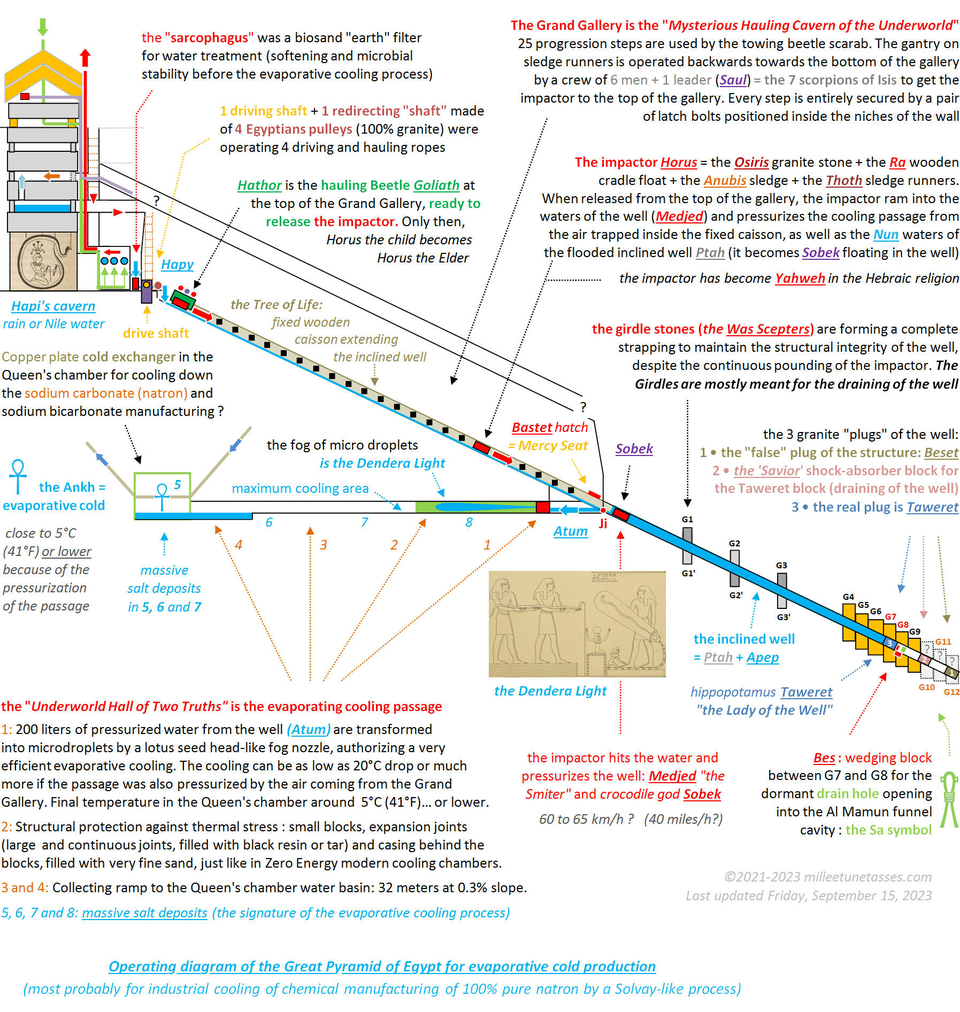
43.19 Operating diagram of the Great Pyramid of Egypt for evaporative cold production
Last updated Friday, September 15, 2023
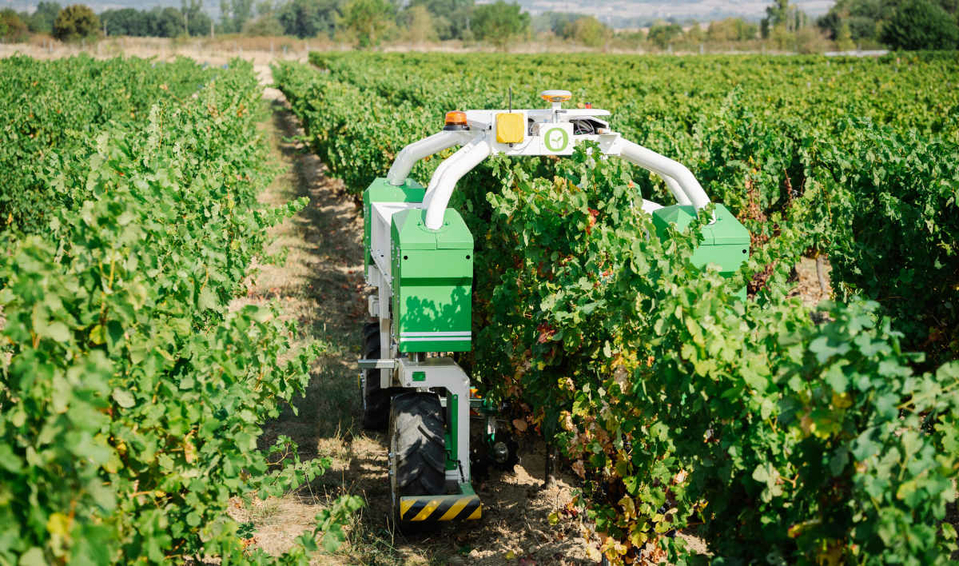
High clearance vineyard tractor, thanks to https://www.naio-technologies.com/ This image: https://www.naio-technologies.com/wp-content/uploads/2021/04/intro-ted-desktop@2x-1920x0-c-default.jpg
43.20 The almost perfect modern model of the hauling Beetle: the vineyard high-clearance tractor
• the two lateral parts only connected at the top
• the central connecting section (imagine there is a central hole in the white structure: that is the Bastet hatch)
• the front bumpers as the modern reinterpretation of Goliath's greaves
• a body without a head at the top: you could have only seen the legs
43.21 Goliath's greaves (mitschath) metaphor is because the hauling Beetle's face actually was its legs
There is a perfect example of the difficulty that scholars are facing, trying to make sense out of the scripture: because it is indeed obviously impossible that David kills Goliath with a sling stone which would have sunk into Goliath's forehead (simply because Goliath wore a helmet), and that Goliath would have fallen "facedown" instead of on his back consecutively of the shock, it is suggested that the sling stone would have instead hit Goliath's knee.
The thing is that the authors of that theory did find the correct clue: Goliath's "greaves" (Hebrew: mitschath), the protecting equipment that Goliath wore on his legs; and they point out that "mitschath" is the plural form of "metsach", which indeed means "forehead".
And if you read the Bible literally, they're right about their explanation, even though it is hard to imagine that David killed Goliath because the sling stone struck him on the leg, and apparently just on one leg. So, do you think Goliath could have been killed after a shot in the leg?
Of course, I let you judge for yourself if there is any chance that might happened this way.
But let me just ask one thing, and keep in mind that Goliath simply is the hauling Beetle: where is Goliath's head (the hauling Beetle's head)? Well, if I've done my job properly, you should say "there is no such thing as Goliath's head", and you would be right: there is no head of Goliath, because there is no head of the Beetle; the hauling Beetle has only legs, so when it is said that Goliath is falling facedown, he is actually falling legs down.
In other words, the legs of the Beetle, i.e. the legs of Goliath, really are its head when he is going forward.
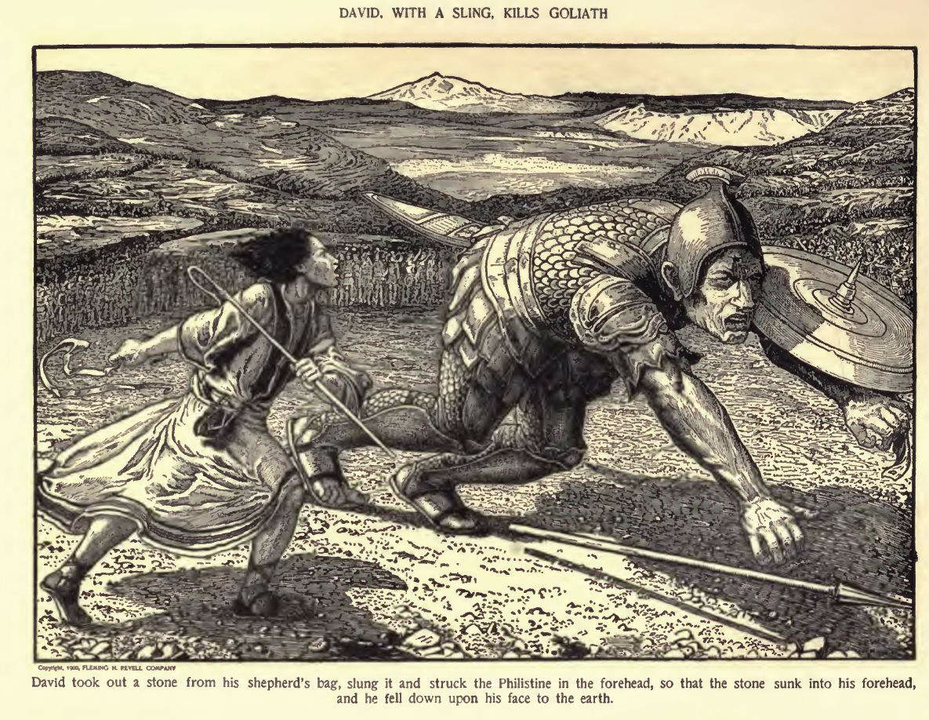
David, with a sling, kills Goliath. David took out a stone from his shepherd's bag, slung it and struck the Philistine in the forehead, so that the stone sunk into his forehead, and he fell down upon his face to the earth. Illustration for The Psalms of David (Fleming H Revell, 1900), illustrated by Louis Rhead. Extracted from public domain version of above work by Mike Cline: https://en.m.wikipedia.org/wiki/File:DavidandGoliath.JPG
43.22 The reason why Goliath is falling face down to the ground... despite he had been shot in the forehead
If you look at most of the representations of the killing of Goliath by David, you'll see that Goliath is systematically more or less on his back, and that's fine, because if David is striking the giant with a stone in the forehead, then he should indeed fall on his back, because of the impact; just like when you see someone being shot by a firearm, the victim is thrown backwards.
But this is not what is described in the Bible: Goliath is supposed to fall face down.
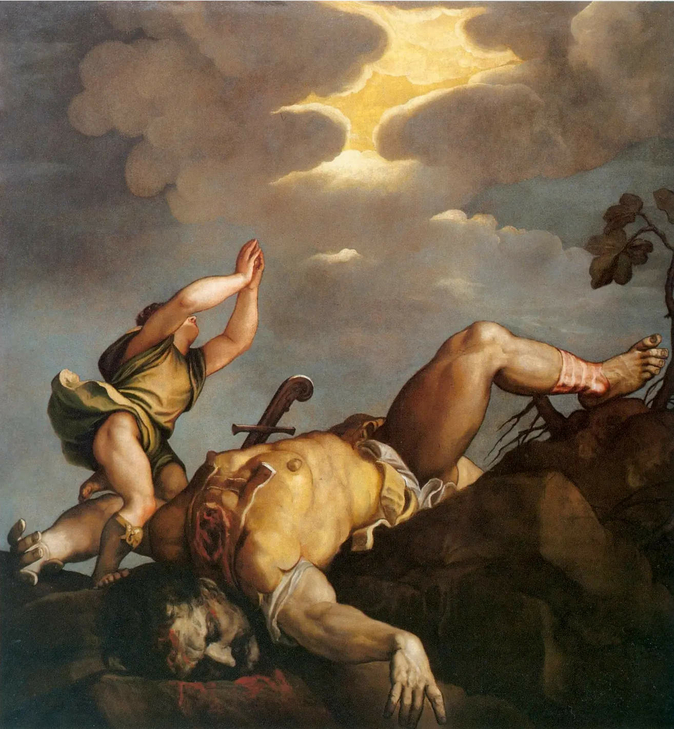
So artists had and still have a choice to make to represent the scene:
• either they stick to the genuine data that Goliath is falling face down, and to make it realistic you put David more or less behind Goliath (like on the above image by Louis Rhead); but then you have another problem: how could David hit Goliath in the forehead if he stands behind him?
• either you disregard the falling face down information and you represent Goliath, dead and on his back.
David killing Goliath, by Titian Vecelli: https://arthive.com/fr/titian/works/500877~David_et_Goliath
But of course there is another solution, and that is the correct one, the one where you understand that once again, for the hundredth time maybe, you know that everything about David and Goliath is a metaphorical description of the operation of the hauling Beetle: the falling of Goliath isn't about the killing of a man, but about the hauling Beetle of the Grand Gallery and the granite stone of the impactor of the Great Pyramid.
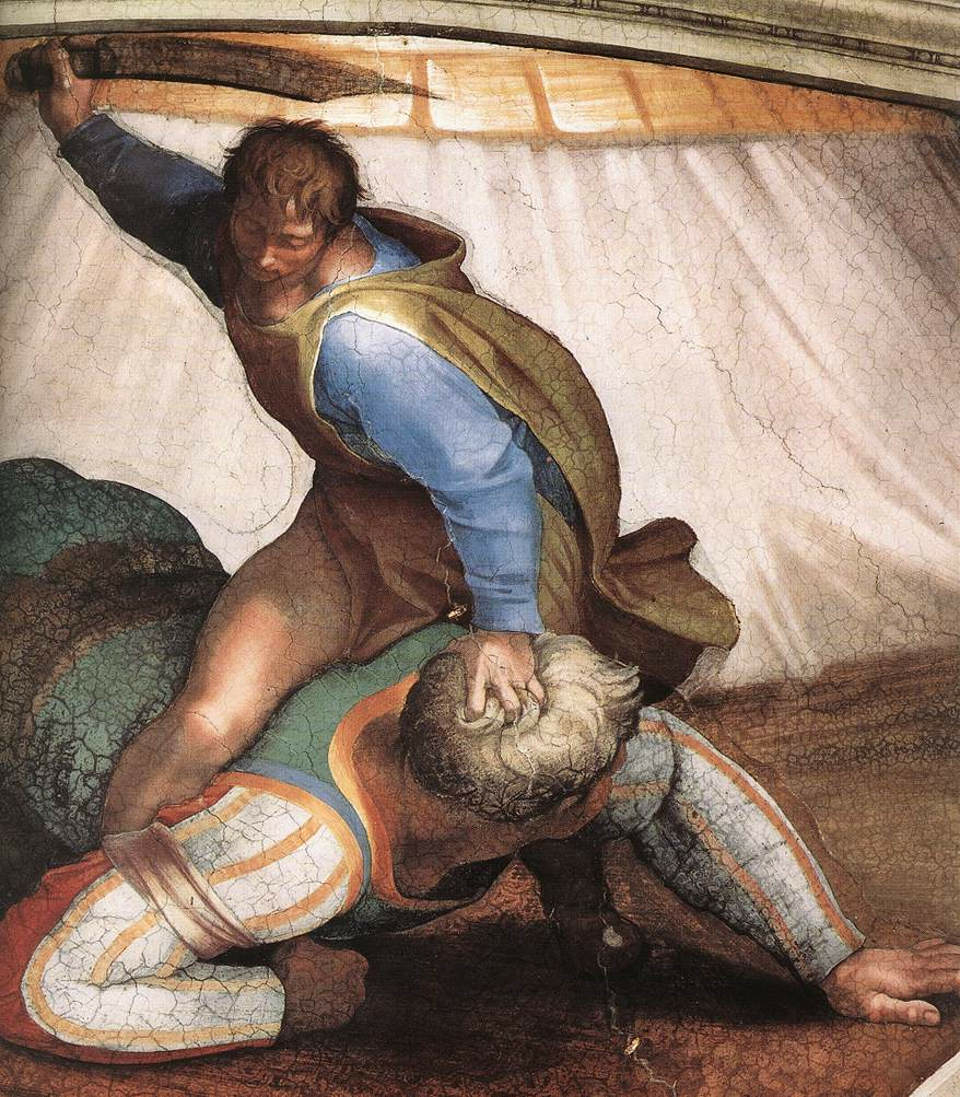
David and Goliath by Michelangelo, on the Sistine Chapel ceiling, with Goliath laying face down onto the ground despite the sling shot in the forehead: https://en.wikipedia.org/wiki/Goliath#/media/File:Michelangelo,_David_and_Goliath_02.jpg

The thing is that in the story of how David kills Goliath, of course Goliath is falling face down on the ground after that David have shot the stone with its sling; but we've also seen, that it is absolutely impossible: Goliath should have fallen backwards; so if you stick to the story it simply doesn't work (unless you don't care, and you just like the story as it is), but if you know that the whole thing is about the stone of the impactor speeding up in the Grand Gallery and literally passing through the hauling Beetle's "legs", then it all makes sense.
The trick here is that when the impactor (and its granite stone), passes though the Beetle, the Beetle is already face down, because it already has finished its job and it is now waiting to be brought back to the top of the Gallery; and in this position, the Beetle would have looked like it was indeed laying on its face onto the north wall of the Gallery; and because of the steep slope of the Gallery, this very north wall would have been seen as the ground itself.
In short, the time scale in the David and Goliath story is all wrong and completely inverted: first Goliath (the Beetle) is laying face down on the ground (the north wall of the Grand Gallery), and only then after the release of the impactor, the stone passes through Goliath's forehead.
Man getting shot, by OooOOOoOo: https://drawception.com/panel/drawing/mc826336/man-getting-shot/
About the reference to the 10 commandments (Section 40), the new organization of the operating phases doesn't change that there were 10 phases: they are only set in a different order.
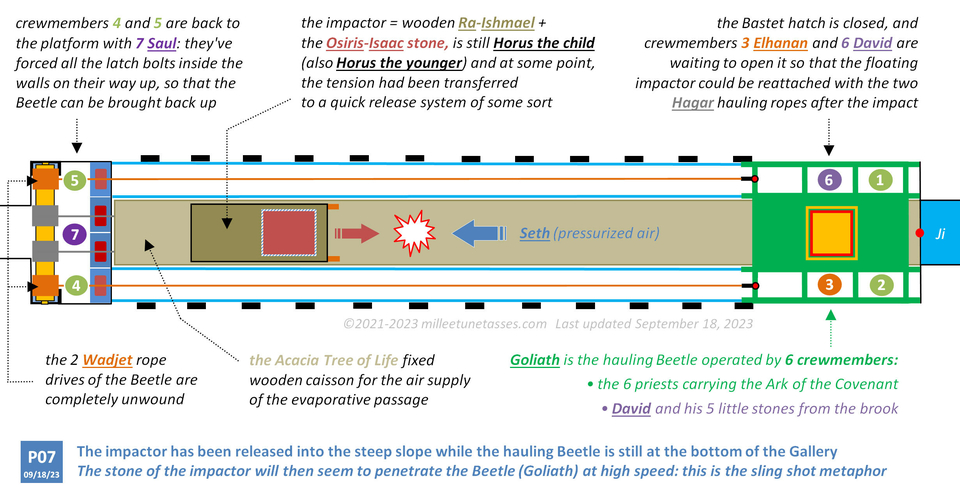
43.23 New P07: the release of the impactor while the Beetle is still resting at the very bottom of the Gallery
We've already seen the first very important modification I had to make, because of the David and Goliath story:
• First modification: Tefen and Befen (the ancient Egyptian glorification of the two crewmembers, that probably could be seen as the one responsible for the operation of the Bastet hatch; one of whom would also have to physically enter the central caisson for the reattachment of the impactor with the two Hagar hauling ropes), or David and Elhanan (the Hebraic reinterpretation of Tefen and Befen), were probably not in the front row of the hauling Beetle during its slow descent, but rather in the middle row so that they could easily operate the Bastet hatch once the Beetle would have reached the very bottom of the Gallery (the Beetle would then rest against the north wall).
And now we have the second and way more important one because of the sling shot metaphor:
• Second modification: when David is throwing a stone at high speed towards Goliath, and that stone is penetrating the Giant right in the middle of the eyes, resulting in Goliath falling face down on the ground, that is the perfect description of the impactor (and its stone), speeding towards the hauling Beetle, resting face down against the north wall of the Gallery. It means that my P10 operating phase was wrong: when the impactor was released from the top platform, the hauling Beetle was not already back up, but was still resting at the very bottom of the Gallery instead.
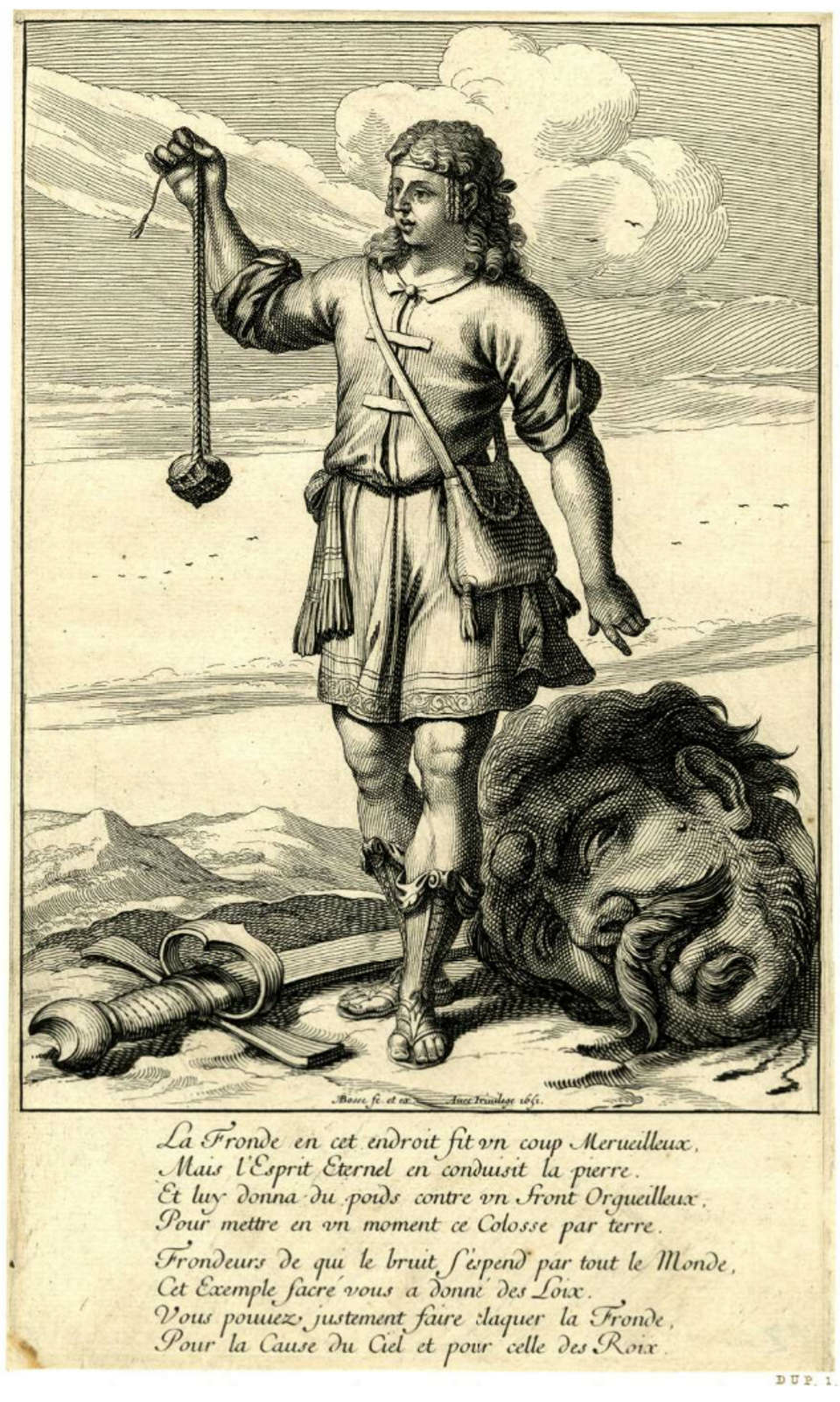
David standing, brandishing his sling, with Goliath's head and a large sword at his feet; poem refering to and supporting the Fronde at the bottom. Etching, 1651 at the British Museum: https://www.britishmuseum.org/collection/object/P_1877-1013-492
43.24 Two ropes used to give speed and energy to a stone: the other perfect metaphor of David's Sling
The sling shot metaphor is indeed a perfect illustration of the operation of the Osiris (also Issac, and Moses) stone.
1 Samuel 17:41-51 ERV Easy-to-Read Version 41 The Philistine slowly walked closer and closer to David. Goliath’s helper walked in front of him, carrying a large shield. 42 Goliath looked at David with disgust. He saw that David was only a handsome, healthy boy. 43 Goliath said to David, “What is that stick for? Did you come to chase me away like a dog?” Then Goliath used the names of his gods to say curses against David. 44 He said to David, “Come here, and I’ll feed your body to the birds and wild animals.” 45 David said to the Philistine, “You come to me using sword, spear, and javelin. But I come to you in the name of the Lord All-Powerful, the God of the armies of Israel. You have said bad things about him. 46 Today the Lord will let me defeat you. I will kill you. I will cut off your head and feed your body to the birds and wild animals. And we will do the same thing to all the other Philistines too. Then all the world will know there is a God in Israel. 47 All the people gathered here will know that the Lord doesn’t need swords or spears to save people. The battle belongs to the Lord, and he will help us defeat all of you.”
48 Goliath the Philistine started to attack David. He slowly walked closer and closer toward David, but David ran out to meet Goliath. 49 David took out a stone from his bag. He put it in his sling and swung the sling. The stone flew from the sling and hit Goliath right between the eyes. The stone sank deep into his head, and Goliath fell to the ground—face down.
50 So David defeated the Philistine with only a sling and one stone! He hit the Philistine and killed him. David didn’t have a sword, 51 so he ran and stood beside the Philistine. Then David took Goliath’s own sword out of its sheath and used it to cut off his head. That is how David killed the Philistine.
https://www.biblegateway.com/passage/?search=1%20Samuel%2017&version=ERV
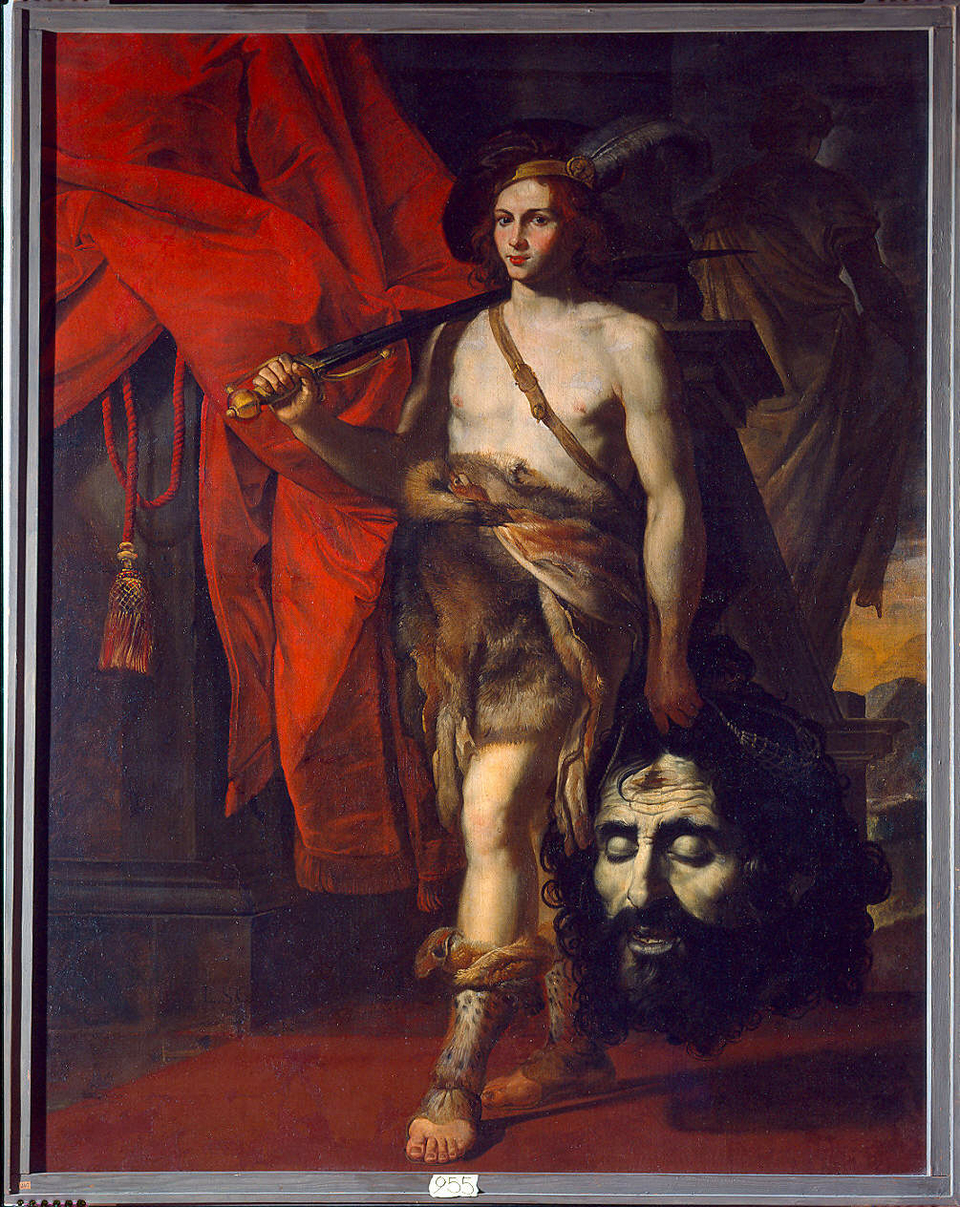
David with the head of Goliath, by Luca Saltarello (attributed), ca. 1610/ post 1632. General catalogue of Cultural Heritage: https://catalogo.beniculturali.it/detail/HistoricOrArtisticProperty/0800404046
43.25 The Beetle was a beast with only four legs and no head: this is why David did "cut off" Goliath's head
David never really did cut off Goliath's head: there never was any head at all on the Giant Goliath, this is why the head is in David's hands, it never was on Goliath's shoulders in the first place.
Another way of seeing it, is that when David was inside the Beetle, Goliath's head was actually the head of David himself: it was David's head (and the heads of the other crewmembers of the Beetle), that would have looked like it was put on the gantry's shoulders.
43.26 The Bastet hatch is the real reason of the cutting of Goliath's head
Of course, there is also another possible reason for Goliath losing his head, and that is the Bastet hatch; and the more I think about it, the more I look at this hatch as the real key: if the hatch really was right in the middle of the connecting section of the Beetle, it would have looked like its head have just been cut off.
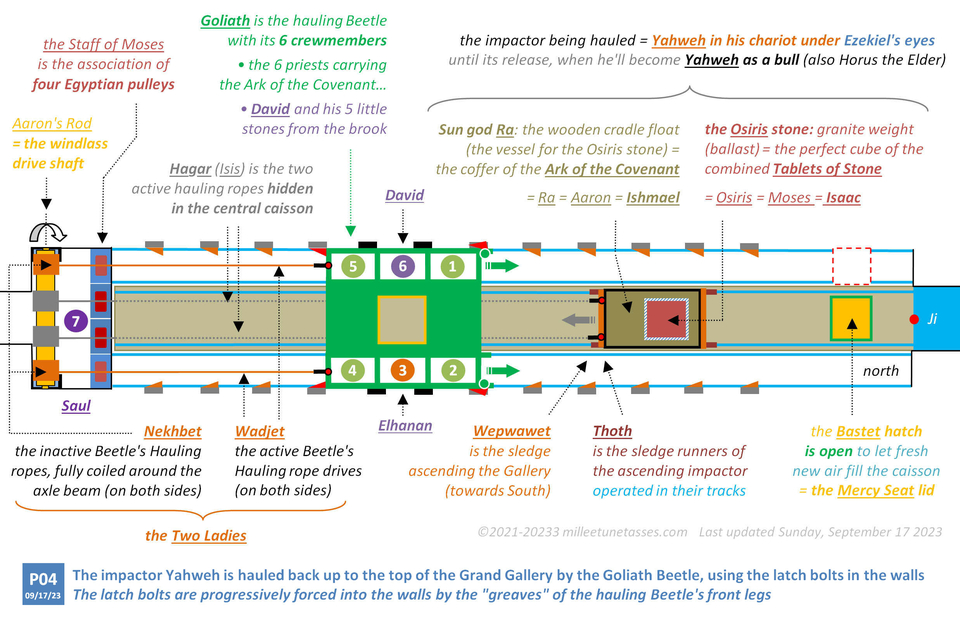
43.27 Operating phase P4 of the Grand Gallery: the hauling process is in progress
At this stage, the impactor is slowly rising into the Grand Gallery while the hauling Beetle (Goliath) is forced down. Because most of the weight of the impactor is in the granite stone nestled inside its wooden part, it would have looked like a stone was thrown towards Goliath's forehead (his forehead really was his front legs).
43.28 The "two between" side of Goliath: "it is as if the writer of 1 Samuel had to invent a term for what Goliath was doing."
If we know that Goliath was called "the two between" in 1 Samuel, I'm not sure I really understand the meaning of this epithet; and I'm not sure scholars understand it either. But maybe, now that we know the exact nature of Goliath, that it was only a wooden gantry structure of two independent units connected by a central section, maybe one would be able to make sense out of it…
What is also very important to my eyes, is that the author specifically mentions the fact that what is characterizing Goliath is absolutely unique in the Bible, and add that "it is as if the writer of 1 Samuel had to invent a term for what Goliath was doing"; and of course this particular comment sounds very well fitting what really was Goliath: a very unique piece of equipment, operated in a very unique place.
"Goliath did not have to stand at 6 cubits, 1 span in order to be measured at that size. The description of Goliath, when read in Hebrew, is an awkward one. I’ll transcribe it here: waytz’ iysh-habenayim mi-mahhanoth pelistiym GAL-YATH shamwo mi-gath gabhwo shesh ‘amoth wa-zareth
וַיֵּצֵא אִישׁ־הַבֵּנַיִם מִמַּחֲנוֹת פְּלִשְׁתִּים גָּלְיָת שְׁמוֹ מִגַּת גָּבְהוֹ שֵׁשׁ אַמּוֹת וָזָרֶת
The term iysh-habenayim, translated as “champion”, is literally formed from iysh or “man” and the dual form of beyn, which means “the two between”. Like so many other terms associated with the Philistines, this word appears only here. It is as if the writer of 1 Samuel had to invent a term for what Goliath was doing." https://www.bedfordroad.org/some-thoughts-on-goliah-of-gath/
43.29 The stone thrown into Goliath's forehead is the stone of the impactor slowly penetrating the Beetle
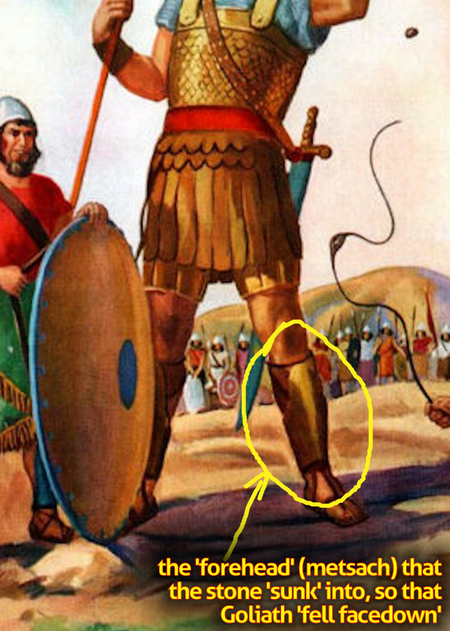
"Medieval Jewish commentators wondered (1) how David’s stone could have sunk into Goliath’s “forehead,” which was presumably covered by his helmet, and (2) why, if struck on the forehead, Goliath would have fallen “facedown” instead of on his back. Deem (“`And the Stone Sank Into His Forehead,'” pp. 349-51) suggests that mesah, the ordinary Hebrew word for “forehead,” should here be translated “greave” (cf. mishat nehosheth “greaves made of bronze”] in v.6). David’s sling stone would thus have struck Goliath on or near his knee, just above one of his two greaves, causing him to fall facedown and enabling David to rush forward and behead him with his own sword. Deem points out that such a reading has an interesting parallel in T Judah 3:1: “I ran out alone against one of the kings, struck him on his leg armor, knocked him down, and killed him” (translation of H.C. Kee in The Old Testament Pseudepigrapha: Apocalyptic Literature and Testaments ed. James H. Charlesworth [Garden City: Doubleday, 1983], 1:796). But Deem admits (1) the occasional possibility of the exposure of the forehead in helmets similar to that worn by Goliath, (2) the weight of Goliath’s frontal armor and the momentum of his forward movement would surely have been enough to cause him to fall facedown rather than backward, and (3) a sling stone sinking “into his greave” seems much less threatening than one sinking “into his forehead.”
[Youngblood, Ronald. Expositor’s Bible Commentary, The, Pradis CD-ROM:1 and 2 Samuel/Notes to First Samuel/First Samuel 17 Notes/First Samuel Note 17:49, Book Version: 4.0.2]
Excerpt from Art Of The Dojo, by James Michael Smith: https://jmsmith.org/blog/david-goliath-2/
43.30 Goliath's greaves metaphor is about the latch bolts forced into the walls by the Beetle's legs
David and the five other crewmembers of the Beetle (David and the five little stones) are forcing the hauling Beetle down, and during that step by step process, the legs of the Beetle would have forced the latch bolts into the walls of the Gallery.
“…on his legs he wore bronze greaves, and a bronze javelin was slung on his back.” 1 Samuel 17:6
"What is most interesting is the word translated as “greaves” (Hebrew: mitschath). It is what’s known as a Hapex Legomenon, that is, a word that only appears once in the entire Hebrew Bible. Translators are justified in using “greaves” to translate the term, mainly because the text tells us he was wearing them on his legs (though we aren’t told if they are shin-guards, knee-guards, or thigh-guards…or a combination of any of these)."
But where it gets really interesting is later in the chapter: “Reaching into his bag and taking out a stone, he slung it and struck the Philistine on the forehead (metsach). The stone sank into his forehead (metsach), and he fell facedown on the ground.” 1 Samuel 17:49
According to some Hebrew scholars, the word ‘mitschath’ is actually a plural form of the word ‘metsach’ which means “forehead.” In other words, the things Goliath was wearing on his legs in v.6 are literally called bronze ‘foreheads’ in Hebrew. This means that it is quite possible–perhaps even likely–that the ‘forehead’ upon which the stone struck Goliath and into which it “sank” in v.49, was one of the bronze ‘foreheads‘ he was wearing on his legs!"
Excerpt from Art Of The Dojo, by James Michael Smith: https://jmsmith.org/blog/david-goliath-2/
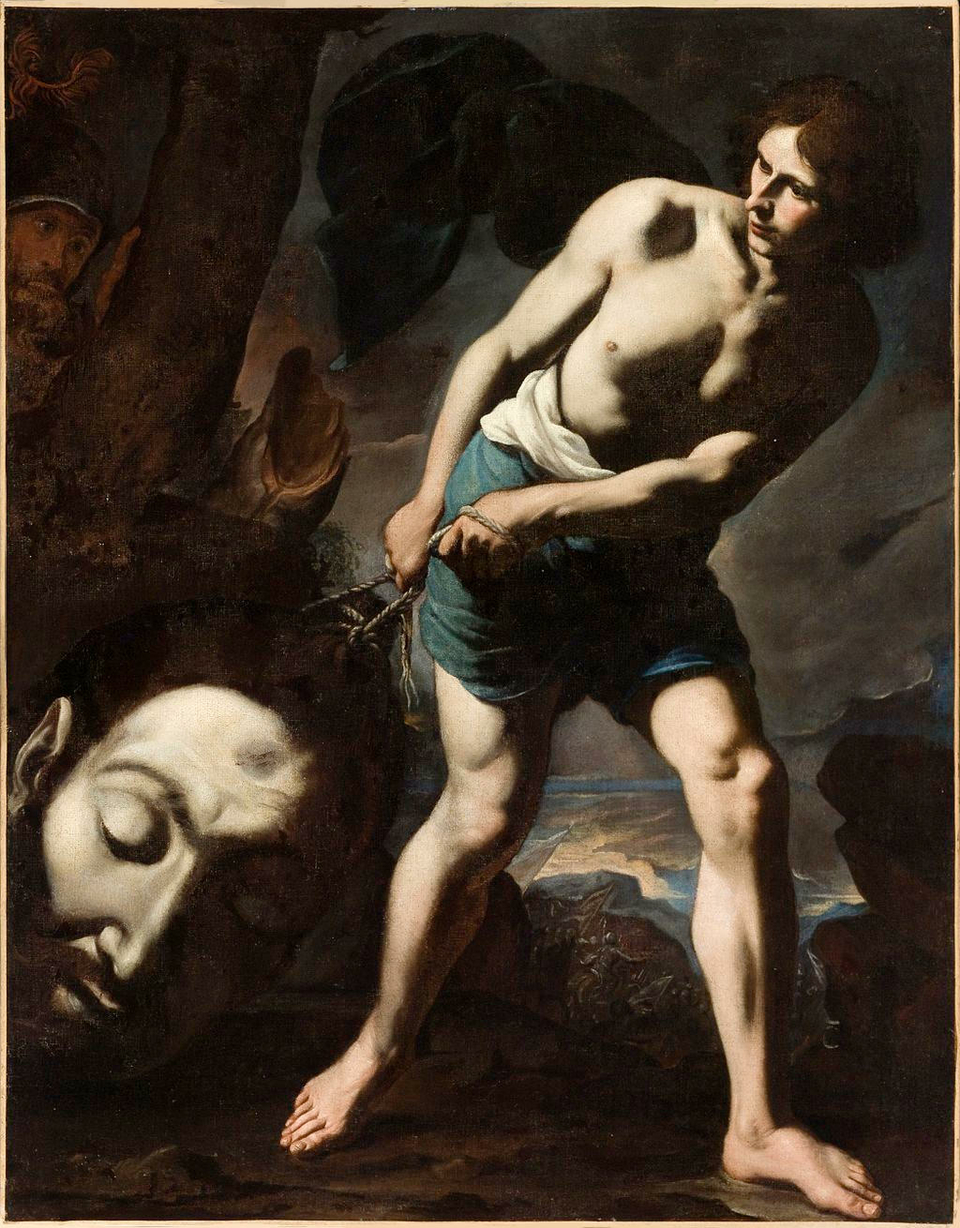
David represented really hauling Goliath, by using a rope in each hand. "David with the Head of Goliath", painting by Andrea Vaccaro. Los Angeles County Museum of Art (LACMA): https://fr.gallerix.ru/album/Lacma/pic/glrx-1599027
43.31 David actually represented here hauling two ropes and towing Goliath!
This painting is exceptional because we can literally see David, trying as hard as he can, to put Goliath into motion; exactly like he was actually doing with the hauling Beetle; the question is to know if the painter knew that ropes were important in the picture or not, and if by drawing them between David and Goliath he also knew it was "wrong", in the way that the ropes weren't between David and the Beetle, but between David and the impactor (David is the one who reattached the two central hauling ropes to the floating impactor), and between Goliath (the Beetle) and the windlass.
If you pay attention to the top part of the painting, you will see Saul above David, and next to Saul two trees: one with an intact trunk and one with a broken trunk. Most probably they are about the two shafts of the platform: an "intact" windlass drive shaft in one single piece (Aaron's Staff), and a "broken" redirecting staff made of the four Ezekiel Egyptian pulleys we've just seen in previous Section 42 (the "broken in two places" Staff of Moses).
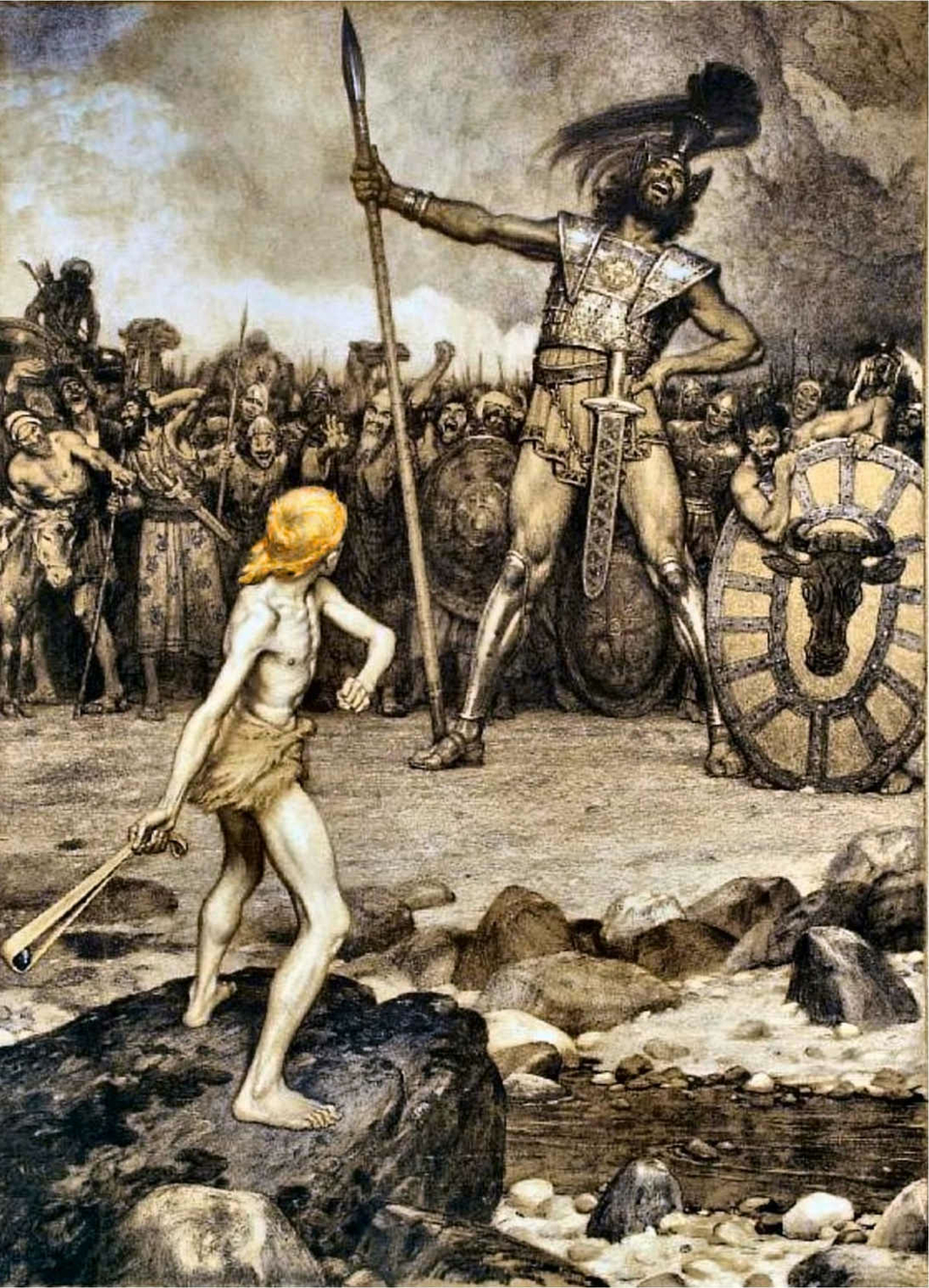
David and Goliath, a color lithograph by Osmar Schindler (c. 1888): https://en.wikipedia.org/wiki/Goliath#/media/File:Osmar_Schindler_-_David_und_Goliath.jpg
43.32 The misinterpreted "contradictions" about David and Goliath
There is inside the David and Goliath story, a real imbroglio that scholars are obviously unable to resolve once and for all: everybody has his own opinion on the subject; but once again, it is only the consequence of a literal reading of the Bible.
• first, people are not sure who really killed Goliath: was it David, or another man named Elhanan?
• second, people are not sure either if there was only one Goliath, or if the Giant also had a brother, named Lahmi.
And you can take the problem any way you want, if you stick to the literal interpretation of the scripture, you'll not be able to make up your mind definitely: contradictions won't go away.
• third, people aren't even sure of the size of Goliath: was he 4 cubits and a span high or 6 cubits and a span high?
"Some claim that a contradiction exists between 1 Samuel 21:9; 2 Samuel 21:19 and 1 Chronicles 20:5, because it appears two different people killed Goliath. The question is, “Who killed Goliath?” Did David or Elhanan kill Goliath, or did both? […] So, who killed Goliath? David or Elhanan? The third part to the answer is that since events in 1 Samuel 17 and 1 Chronicles 20 occurred about 44 years apart, there is sufficient and necessary reason to conclude that Elhanan killed Lahmi the brother of Goliath, in 1 Chronicles 20. The description of the events are different, the events occurred about 44 years apart, and scripture records there were other giants in the land. Therefore, the answer is that David killed Goliath. Elhanan killed his brother Lahmi."
https://www.neverthirsty.org/bible-qa/qa-archives/question/who-killed-goliath-david-elhanan/
"In 2 Samuel 21, verse 19, the Hebrew Bible tells how Goliath the Gittite was killed by "Elhanan the son of Jaare-oregim, the Bethlehemite". The fourth-century BC 1 Chronicle 20:5 explains the second Goliath by saying that Elhanan "slew Lahmi the brother of Goliath", constructing the name Lahmi from the last portion of the word "Bethlehemite" ("beit-ha’lahmi"), and the King James Bible adopted this into 2 Samuel 21:18–19, but the Hebrew text at Goliath's name makes no mention of the word "brother". Most scholars dismiss the later 1 Chronicles 20:5 material as "an obvious harmonization" attempt." https://en.wikipedia.org/wiki/Goliath
"The oldest manuscripts, namely the Dead Sea Scrolls text of Samuel from the late 1st century BCE, the 1st-century CE historian Josephus, and the major Septuagint manuscripts, all give Goliath's height as "four cubits and a span" (6 feet 9 inches or 2.06 metres), whereas the Masoretic Text has "six cubits and a span" (9 feet 9 inches or 2.97 metres). Many scholars have suggested that the smaller number grew in the course of transmission (only a few have suggested the reverse, that an original larger number was reduced), possibly when a scribe's eye was drawn to the number six in line 17:7." https://en.wikipedia.org/wiki/Goliath
43.33 There isn't any contradiction anymore if you know Goliath is the hauling Beetle
• first and second, if it is correct to talk about one Goliath, just like it is correct to talk about one hauling Beetle, it would be preferable to only talk about the two separate half-Beetles: there were indeed two giants in the Grand Gallery. But even if it is probably still possible that these two half-Beetles weren't physically connected with each other after all, they were most probably really connected into one single structure.
In other words, Goliath could have been seen either as one single Giant all by himself, or as a pair of Giants, and this is where the second Giant Lahmi, Goliath's brother comes into play.
• third, there doesn't have to be a contradiction in Goliath's height either: because Goliath isn't a man but a wooden gantry you could actually give both his height and his width. Probably the 4 cubits and a span are about its width, and 6 cubits and a span are about its height.
But then, there is another problem: the width of the Grand Gallery being 4 cubits, how could the Beetle be 4 cubits and one span width? First, there is a problem with the unit itself? Which "cubit" unit is the Bible using in the David and Goliath story? Because there are many cubits, really. Of course if the cubit used is a "small" cubit, then there is no more problem, but even if the units are the same, there still could be an explanation: remember that everything in the ancient Egyptian religion and in the Bible is metaphorical, and that in particular they both like to play with words, with numbers and with units (remember the 360 degrees in a circle, in the ancient Egyptian myth which had been compared to the 365 days of a year, just to play with these two very close numbers, previous Section 42); so when it is said that the height of Goliath was either 4 cubits and a span, or 6 cubits and a span, the mention of the extra span is suspicious. If they loved so much to play with words and metaphors, they could have simply wanted to add the word "span" to the 4 and 6 numbers.
For example, let's say the Beetle was really 4 cubits wide, and that you simply wanted to add to the story, as a little bonus, that you could only have slide you hand in the space between the wooden structure of the Beetle and the walls, then you would have simply add the term "span" to the genuine 4 cubits data.
Of course, this is not even a theory, simply kind of an exercise in style to try to illustrate the difficulty to use the two different heights of Goliath found in the Bible. The most important is to understand that they are not contradictory at all, but that they are complementary, even if it will be very difficult to be sure of anything about their interpretation.
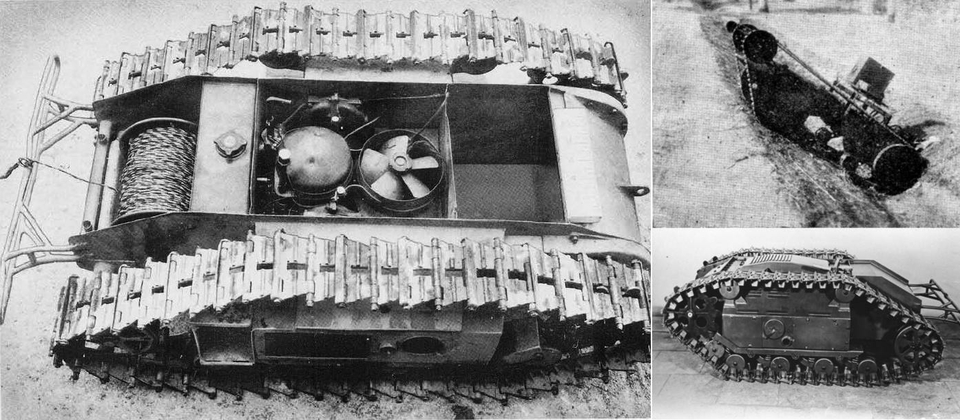
The interior of a Goliath, SdKfz. 303, showing the petrol engine, control cable reels and the space for the warhead. Thanks to the US Department of Ordnance - Catalog of Enemy Ordnance Manual Vol. 1 - 1945 GOLIATH German remote controlled tracked vehicle opened, interior, fuel powered: https://en.wikipedia.org/wiki/Goliath_tracked_mine#/media/File:Goliath-interior.jpg
43.34 The worthy successor of the hauling Beetle: the "Goliath beetle tank"
Turns out I'm not the first one to have associated a Goliath with a beetle! Damn!
"The Goliath tracked mine (German: Leichter Ladungsträger Goliath, "Goliath Light Charge Carrier") was a series of two unmanned ground vehicles used by the German Army as disposable demolition vehicles during World War II. These were the electrically powered Sd.Kfz. 302 and the petrol-engine powered Sd.Kfz. 303a and 303b. They were known as "beetle tanks" by the Allies." https://en.wikipedia.org/wiki/Goliath_tracked_mine

43.35 If David is one of the six crewmembers of the hauling Beetle, then the Star of David Hexagram is about the whole party... including the seventh one: the leader of the team himself, Saul
The Star of David has become one of the most know symbol in the entire modern world, and now that we know what really is representing David, we can also decipher the Star of David.
Everybody knows that the Star of David is about the glorification of the number 6 (the hexagram), and the number 7 (the central point of the hexagram).
But the most important part of the Star, is the fact that the so-called hexagram isn't really an hexagram, instead it is the association of two interlocked triangles; in other words, the main part of the Star of David isn't really just the glorification of the number 6, but twice the glorification of the number 3.
And of course, this is about the two half-Beetles of 3 crewmembers each, who associated their efforts to raise the impactor (Yahweh), again and again, all day long.
We've already seen two ways of describing David and his five teammates working into the Beetle:
• you can compare them to prisoners in their individual cells (hence the prisoners onto the ancient Egyptian scarab amulets, Section 28)
• you can compare them as stones into the squares of a game board
• but you can also described them as being protected by some kind of shield; and this is this metaphor which had been used in the Star of David: The Star of David as depicted on the flag of Israel. "The Star of David, the symbol of the Jewish faith and people. Also called Shield of David after the Hebrew Magen David."
The Star of David as depicted on the flag of Israel. "The Star of David, the symbol of the Jewish faith and people. Also called Shield of David after the Hebrew Magen David.", by Zscout370: https://en.wikipedia.org/wiki/Star_of_David#/media/File:Star_of_David.svg
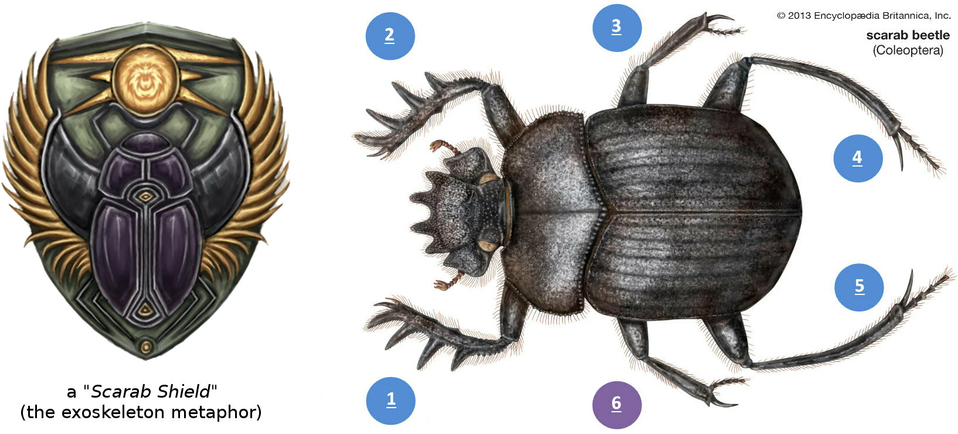
Scarab Shield by nith47 on Fandom: https://something-wicked.fandom.com/wiki/Scarab_Shield?file=Scarab_shield_by_nith47.png
Sacred scarab beetle at Britannica: https://www.britannica.com/animal/scarab-beetle#/media/1/526654/139393
43.36 The Shield of David is about the "scarab shield" metaphor
Even if a scarab Beetle isn't literally what is called a "shieldbug", or "shield bug", this is the very metaphor which has been used for the hauling Beetle in its Shield of David reinterpretation: the Star of David (the Shield of David) is about the exoskeleton of the wooden hauling Beetle, such as the exoskeleton of the Scarab Shieldbug: https://www.naturespot.org.uk/species/scarab-shieldbug
Of course, like all insects, scarab beetles come with 6 legs; when you think it through, the scarab beetle metaphor of the hauling gantry of the Grand Gallery, simply is perfect and sublime.
43.37 The Seal of Solomon (from which originates the Star of David) was indeed about giving power
"The Seal of Solomon or Ring of Solomon (Hebrew: חותם שלמה, Ḥotam Shlomo; Arabic: خاتم سليمان, Khātam Sulaymān; Turkish: Mühr-ü Süleyman) is the legendary signet ring attributed to the Israelite king Solomon in medieval mystical traditions, from which it developed in parallel within Jewish mysticism, Islamic mysticism and Western occultism. It is often depicted in the shape of either a pentagram or a hexagram. In religious lore, the ring is variously described as having given Solomon the power to command the supernatural, including shedim and jinn, and also the ability to speak with animals. Due to the proverbial wisdom of Solomon, it came to be seen as an amulet or talisman, or a symbol or character in medieval magic and Renaissance magic, occultism, and alchemy." https://en.wikipedia.org/wiki/Seal_of_Solomon
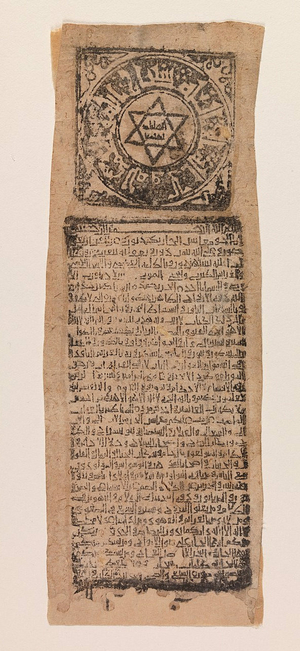
43.38 The Seal of Solomon and the "ability to speak with animals"
Maybe the biggest difference between the ancient Egyptian religion and the Hebraic religion, despite the fact that the Bible is only focusing on the operation of the impactor and doesn't seem to care about all the other scientific and technological glorifications of the Egyptians (probably related to the fact that the Hebraic religion is entirely meant for the people, while the ancient Egyptian religion had been made for the only interest of the pharaohs), is that the ancient Egyptian religion with over 2,000 gods and goddesses, each and every one of them being a certain aspect of the glorification itself, relentlessly used animals as illustrations of what these deities were all about.
Horus as a falcon, because of the high speed dive of the animal; Taweret as an hippopotamus, because of the way the animal likes to stay underwater at the bottom of the river, the pound or the lake; the cow goddesses Hathor and Mehet-Weret, because of the way the animal was used as a hauling living animal; or the endless representations of rams with magnificent ram horns, because of the ramming capabilities of the impactor; additionally of course to the scarab beetles and their exoskeleton shield, there are endless examples of this glorification transfer towards animals.
And even if the Jewish religion only used (to my knowledge) one animal, the Bull as a representation of Yahweh himself; the Seal of Solomon was clearly seen as directly referring to these animals:
About the Seal of Solomon: "It is often depicted in the shape of either a pentagram or a hexagram. In religious lore, the ring is variously described as having given Solomon the power to command the supernatural, including shedim and jinn, and also the ability to speak with animals." https://en.wikipedia.org/wiki/Seal_of_Solomon
Talismanic scroll bearing Solomon's Seal, 11th-century, Fatimid Caliphate; from the Metropolitan Museum of Art, New-York: https://en.wikipedia.org/wiki/Seal_of_Solomon#/media/File:Talismanic_Scroll_at_the_Met.jpg

« Livre que fist Jehan BOCACE de Certalde des cleres et nobles femmes, lequel il envoia à Audice de Accioroles de Florence, contesse de Haulteville » by Boccace, Jean (1401-1500), at the Bibliothèque Nationale de France Gallica (cropped and slightly edited): https://gallica.bnf.fr/ark:/12148/btv1b10509080f/f151.item.zoom
43.39 What really is the Boccace weaving machine painting about?
When you really focus on the details, the above painting representing a woman working on a weaver can be very troubling:
• not only the woman operating the weaver's beam is in the exact same position than were the crewmembers of the Beetle: she is facing the beam
• but the same way Saul was supervising the process in the Great Pyramid, we also have another woman supervising the other woman's work
• and finally there is this very strange bowl of stone in which is burning a fire; and if I hadn't write previous Section 42 about the Wheels within the Wheels of Ezekiel, which were producing sparks (because of the metaphor of the two granite stones generating friction, hence sparks, right next to the place where Saul was positioned), I certainly wouldn't have been interested at all by this bowl…
Is it normal to make a fire right next to a weaving machine, I think is the question that would need to be answered.
But what is certain, is that for a very long time, some informations about the operation of the Grand Gallery survived through the arts, we've seen the best example of this with the Emerald Tablet (Section 35); so the question is to know if this painting by Jean Boccace (1401-1500), is one of these "special" paintings, or if it is just a plain and normal painting about a weaving machine being operated by a few girls…
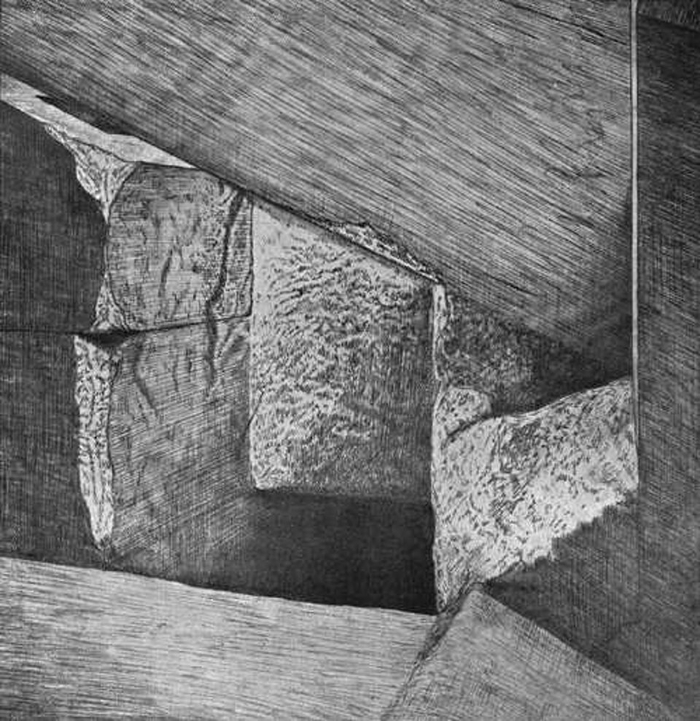
Great Pyramid Passages Volume 1, 1910 edition, by John and Morton Edgar. Plate CXLVII, page 272. "The well-mouth in the north-west corner of the Grand Gallery of the Great Pyramid of Gizeh, from the east; showing the horizontal joint between the upper and lower portions of the square-cut-off Ramp to the south (left); the fragmentary remains of the missing ramp-stone, in the north (right) corner; and the tipper end of the First Ascending Passage to the right; also part of the floor of the Horizontal Passage to the Queen's Chamber in the foreground.
https://archive.org/details/GreatPyramidPassagesVol11910Edition/page/n281/mode/1up
43.40 The problem of where was installed the Bastet hatch and its probable link with the "well-shaft" towards the subterranean chamber
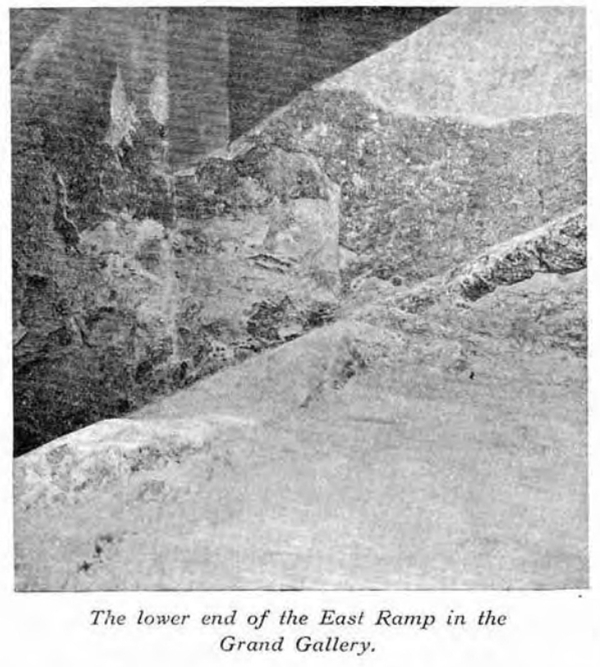
43.41 The Junction imprint
Great Pyramid Passages Volume 1, 1910 edition, by John and Morton Edgar. Plate CXLIX, page 274.
"The lower end of the East Ramp in the Grand Gallery": https://archive.org/details/GreatPyramidPassagesVol11910Edition/page/n283/mode/1up
The Pyramids of the Cold version 2 (May 2023 - March 2024)
Summary of the study and Table of Contents
Part A: The evaporative cooling process
Section 1 • The horizontal evaporative cooling passage layout
Section 2 • The Dendera Light and the creation of the fog of microdroplets by the fog nozzle
Section 3 • The water cycle glorifying metaphors: Geb, Shu, Nut, Tefnut
Section 4 • The theorization of the evaporative cooling process by Akhenaten and Nefertiti
Section 5 • The theorization of the evaporative cooling process in the Weighing of the Heart
Part B • The inclined well of the Great Pyramid of Giza
Section 6 • The inclined well layout and the girdle stones
Section 7 • The Taweret "Lady of the Well" temporary sealing granite plug of the well
Section 8 • The Bes temporary wedging block immobilizing Taweret
Section 9 • The draining of the well
Section 10 • The Great Serpent Apep and the snake water metaphors
Section 11 • The Was scepter and the control over "snakes"
Section 12 • The beating Heart of the Great Pyramid
Part C • The composite impactor of the Great Pyramid (Horus, Ra, Osiris, Medjed, Sobek...)
Section 13 • The wooden and stone composite design of the impactor: Ra and Osiris
Section 14 • The endlessly immersed Osiris stone and the seed metaphor
Section 15 • The Anubis sledge and the bobsled mask
Section 16 • The sledge runners of the impactor: Thoth
Section 17 • Medjed: the smiter nobody can ever see
Section 18 • The Apis bull and the ramming impactor's metaphors
Section 19 • The crocodile god Sobek impactor (more or less) floating in the waters of the well
Section 20 • The Obelisk and the Benben stone rising from water
Part D • The Grand Gallery's of the Great Pyramid of Giza
Section 21 • The Sacred "sloping paths" of the "oval-shaped cavern of the act of Hauling"
Section 22 • The central wooden caisson of the Gallery: Sekhmet and the Triad of Memphis
Section 23 • The hauling ropes of the Grand Gallery: Isis, Nephthys, Hatmehit, Wadjet and Nekhbet
Section 24 • The hauling Beetle and the Seven Scorpions of Isis
Section 25 • The Great Cow goddess Hathor and the operating cycle of the hauling Beetle
Section 26 • The 10 operating phases of the Grand Gallery
Section 27 • The guide to the Afterlife for the smart traveler and the canopic jars
Section 28 • The scarab amulet glorifications of the hauling Beetle
Part E • The very large and roughly finished sarcophagus of the Great Pyramid
Section 29 • The biosand filter sarcophagus of the Great Pyramid
Section 30 • The Elephantine Triad deification of the biosand filter of the Great Pyramid
Section 31 • The Great Pyramid's operating flat roof and the water supply issue
Part F • Chemical manufacturing and industrial cooling before the Great Pyramid
Section 32 • The Serdab and the "Refreshment of the Gods" Step Pyramid of Djoser
Section 33 • Sneferu's Red Pyramid and the accumulated ammonia
Section 34 • The Disc of Sabu and the Solvay process for pure natron manufacturing
Part G • The tremendous impact of the Great Pyramid on the whole ancient world
Section 35 • The hidden secrets of the Hermetica Emerald Tablet (around 1600 C.E.)
Section 36 • Thor and the magical Hammer in the Great Hall of Bilskirnir
Section 37 • The Churning of the waters of the Ocean of Milk (Hindu mythology)
Section 38 • The Tibetan prayer wheels and the Grand Gallery's operation
Section 39 and Conclusion • The cooling water of spitting Kebechet
Part H • Epilogue
Section 40 • The smiting Ark of the Covenant and the Ten Commandments
Section 41 • The 293 kilograms windlass Staff of Moses and Aaron... and the First Plague of Egypt: water turning into blood
Section 42 • Ezekiel's Four Egyptian pulley "Wheels within the Wheels" and the four angel ropes
Section 43 • David, Saul, two giant Goliaths, five little stones, an aeolian harp... and a weaver's beam
Section 44 • The holy water fonts and the biosand filter
Part I • The magicians of the Great Pyramid of Giza
Section 45 • The Legend of Khufu and the "magician" polymath Imhotep
Section 46 • The two magical eyes of Isis and the brilliant but painful flame of her twin sister's braids
Poster un commentaire

